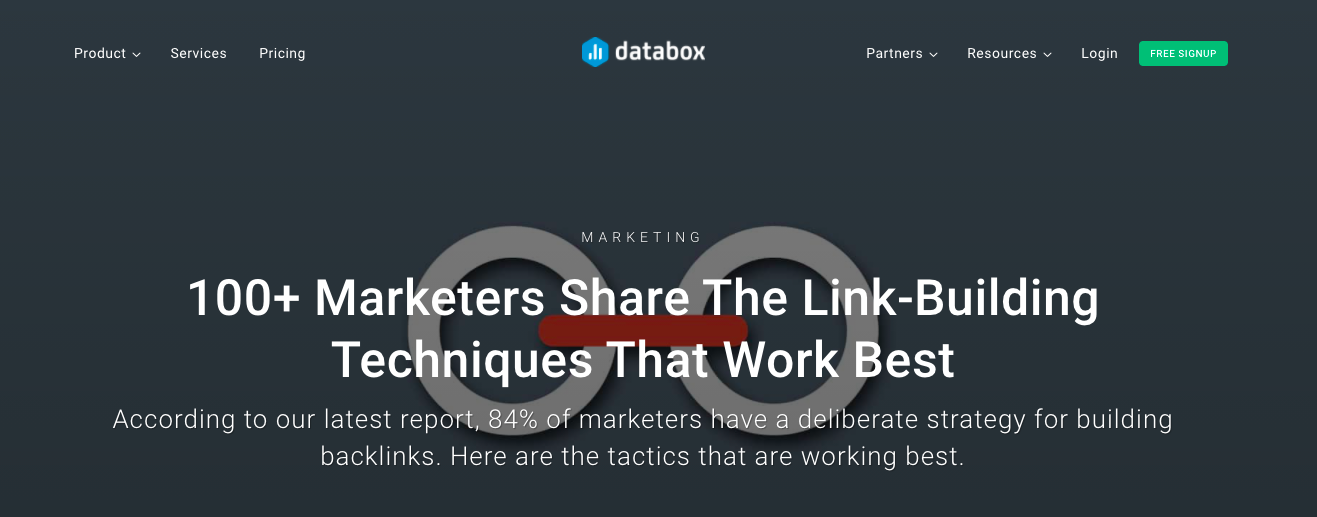Influencer marketing has exploded over the past several years with the rise of social media stars. This type of marketing is much more powerful than it may appear – which is why you need an influencer marketing strategy.
Influencer marketing is more than just likes or shares on social networks; it’s like a single customer recommending your product to thousands, or even millions, of friends.
How many other channels allow you to tap into a large audience of ideal prospects that are eager to trust your product or service?
So how do you build a successful influencer marketing strategy to grow your business? Should you target celebrities or micro influencers? How do you find these influencers? How do you track influencer marketing success?
This ultimate guide has the answer to all of these questions and more.
TABLE OF CONTENTS:
Chapter 1: First, a Brief Overview of Influencer Marketing
This first chapter is a general overview of influencer marketing, including what is an influencer, how to choose an appropriate person to achieve maximum ROI, and where to find legitimate influencers. (As well as our influencer marketing tips from the biggest lesson we’ve learned from implementing this strategy. 😀 )
Then, as per the table of contents above, we’ll dive deeper into each aspect of an influencer marketing strategy in chapters 2 through 10.
1) What Is Influencer Marketing?
Influencer marketing is a strategy that businesses use to promote their products and services by partnering with popular social media users or bloggers. Influencers usually have a large, engaged audience that brands can tap into to build credibility and even drive sales.
When you see Beats by Dre, which is owned by Apple now, you might wonder why it was so popular. It’s because every single celebrity, from LeBron James to the Kardashians, appeared in TV commercials saying: “Hey, you have to wear these headphones. They’re cool. We all wear them.”
That’s a form of influencer marketing.
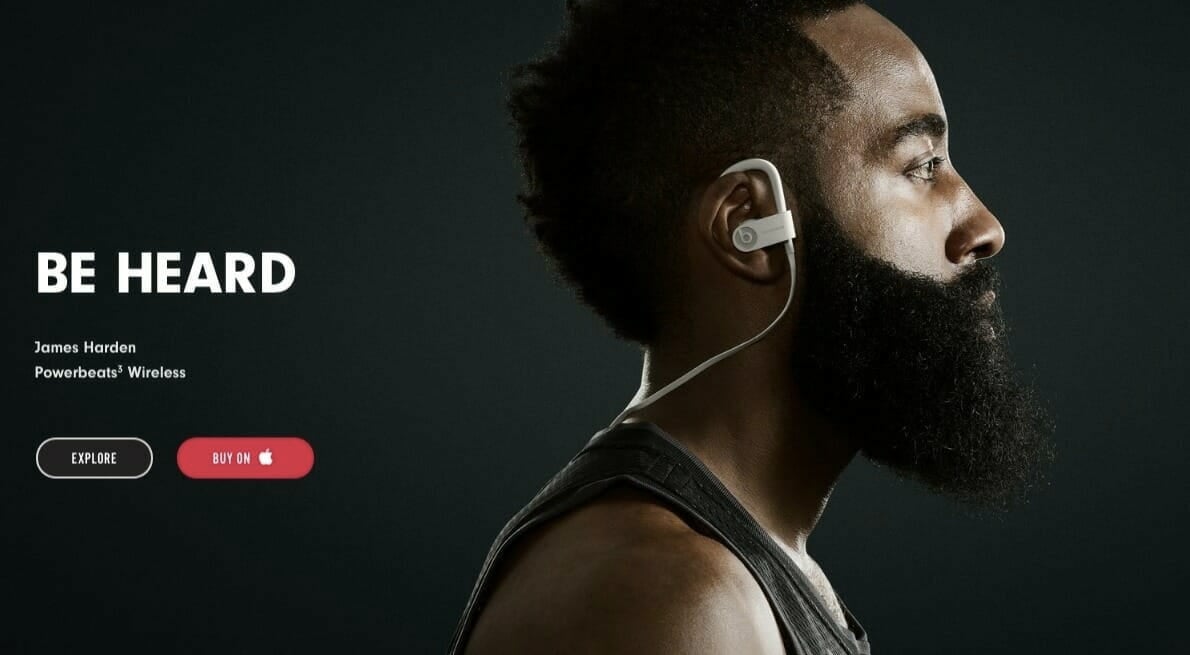
Partnering with influencers is a number one marketing strategy for many brands. These are the benefits of influencer marketing:
- Reach a bigger audience
- Build trust for your brand
- Grow your social following
- Increase site traffic
- Get more leads
- Drive sales
When you see celebrities and other famous people you look up to wearing things or using certain products or services, you are much more likely to purchase them as well.
The different types of influencers whom you see on social platforms have a few hundred thousand or over a million followers on Instagram or Snapchat or YouTube. These people have built up their earned audiences, which is why they’re called influencers.
Keep in mind that building up a following is very hard. YouTube and Facebook are paying these people good money because they have these huge organic audiences.
2) How to Leverage Influencer Marketing
The easiest way to leverage influencer marketing is to pay influencers directly for posts.
Take Instagram, for example. There are tons of models on there pushing their protein, water bottles, and similar products. These models are being paid per Instagram post. You don’t even have to be a huge company for this type of marketing to be valuable.

Let’s say you’re in e-commerce and you’re pushing products. You don’t necessarily need influencers on the level of LeBron James or Kim Kardashian. I was just talking to an influencer the other day with 500,000 followers. I asked her how much she was getting and she told me that she’s getting paid about $800 per post. She’s 24 years old. At that age, that’s a lot of money for very little work.
If your e-commerce company is paying $800 per post and your average order value is $50, you can see how the numbers add up in your favor. Let’s say one of this woman’s posts gets you $5,000 worth of orders. That’s a deal you’d do all day every day.
In fact, you’re going to be looking for even more Instagram influencers. This is something you want to double-down on.
Learn more in Chapter 2: How to Grow Your Business With Mutually Beneficial Influencer Marketing
3) The Biggest Lesson I’ve Learned from Influencer Marketing
I’ve implemented an influencer marketing strategy for a while now. I’ve even done it for my personal brand to see if I can increase my popularity, which would help increase the overall brand awareness of Single Grain and Growth Everywhere.
What I ended up learning is that when your influencers are posting sporadically, it doesn’t have a big impact. But if you have a huge marketing budget and do it consistently and frequently, you can really start a movement.
I don’t have the budget that Beats by Dre had, so I did the next best thing. I tried to have influencers post once a week, every week, on a specific day. When I had all the influencers do it on a Monday or Wednesday and stuck to that schedule, I noticed a much bigger impact.
That’s because on those specific days thousands of people were seeing my name and my brand multiple times from different influencers in the same space. They’re thinking, “Wow, I’m not just seeing one or two pictures, I’m seeing five or six or seven on the same day from this company or of this product or service. Maybe I should check it out now.”
But when someone sees it sporadically over a week, it doesn’t have as much of an impact compared to that rapid-fire frequency in a short period of time.
The last thing I want to add is that you should track your influencer ROI with specific coupon codes. That way you can track the effectiveness of any given campaign from any given influencer.
Now that you’ve gotten a general overview of influencer marketing, let’s move on to growing your business with an influencer marketing strategy.
To keep up-to-date on influencer marketing, check out 9 Influencer Marketing Trends You Can’t Ignore
Chapter 2: How to Grow Your Business with Mutually Beneficial Influencer Marketing
Referrals have long since been one of the most effective marketing strategies.
If you have a problem and one of your friends tells you about a great solution for it, there is a good chance that you’ll go buy it.
Influencer marketing is just like that – only at scale. When influencers tell their fans and followers about how great your product is, there is a much higher chance that their audience will convert, simply because they need the product and trust the influencer.
Typically, the seller or marketer will give a special discount code just for the influencer’s audience in order to track how effective the campaign is.
1) The Growth of Brand Influencer Partnerships
About 82% of people follow the recommendations of micro influencers.
Brands and influencers are now forging long-term relationships:
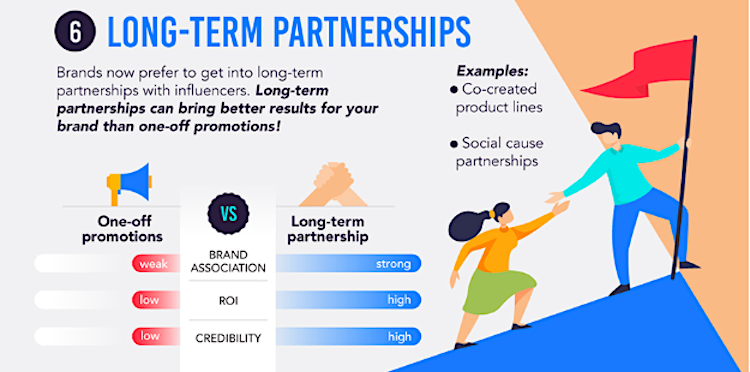
Long term relationships are not only more attractive to influencers, but they also provide a much better ROI. For example, on the Marketing School podcast, we have a single partner, DreamHost, which has renewed with us over the years. Clearly, that partnership is still providing value, so they continue to run the campaign.
It should be no surprise that the influencer marketing space is expected to grow from just over $13 billion to at least $21.1 billion by the end of 2023.
As paid ad costs continue to rise on social platforms like YouTube and Instagram, businesses have to find a way to survive. This is where influencer marketing steps in.
Working with influencers can be cheaper than paid advertising and is much more effective because you can buy into the influencer’s loyal (and often huge) following.
The influencer marketing space still has a long way to go before it becomes saturated, though you should expect it to become more expensive soon because it works so well.
Still not sure if you should jump on the bandwagon?
Take a look to see if there are other brands in your industry running ads with influencers. You’ll probably notice that several are, and if any of them have been running ads for several months or years, it’s a good sign that it’s working.
Even if you don’t see anyone using it in your industry, it still might be worth finding a highly compatible influencer and testing it out.
2) Why Brands Rely on Influencer Marketing
Because influencer marketing is still a fairly new strategy, it continues to be a viable solution for marketers who are willing to think outside the box on building trust with their audience.
Here’s why brands are relying on influencer marketing.
- Influencers Have Real Power. Nearly 55% of consumers read at least four reviews prior to purchasing a product, and about 84% of consumers have made a purchase based on an influencer’s recommendation. It’s hard to ignore the power of these unofficial brand ambassadors:

- Influencers Are Social. According to Oberlo, everyone uses social media, even your grandparents:
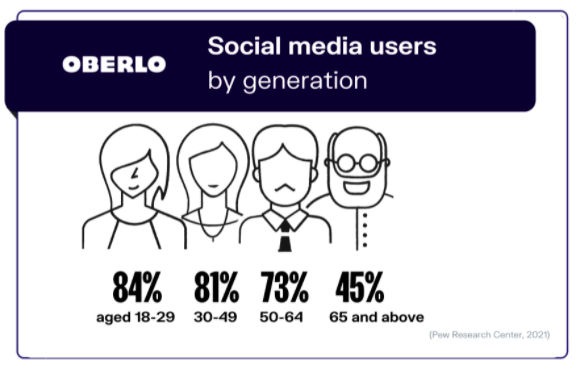
- Influencers Affect Your SEO. Having an influencer help you increase your follower count on various social media platforms, particularly TikTok and Instagram, also improves your SEO. While a social presence isn’t a confirmed ranking factor, it is a signal to search engines that you have a substantial following which they equate to brand quality. As you are probably aware, brands are indeed the way of the future.
3) Brand + Influencer: Make It Mutually Beneficial
Just like any relationship, your influencer program should be a two-way street. If your brand is the only party that benefits, you likely won’t get anyone to agree to partner with you, and if they do, they probably don’t have a great following.
The average formula looks something like this: $100 x 10,000 followers + extras = total rate
There are several different ways in which you can compensate influencers:
- Cash. This is the most common form of compensation. Most influencers prefer this method and will request it. Just make sure that the person is truly invested in your brand so they can put their heart into the project rather than just take the cash and run.
- Free product or discount. Why not offer somebody a free product or discount in exchange for a shout out? This is how GymShark initially grew its user base. When influencer marketing was still in its infancy, they sent their products to YouTube influencers for free, and in turn, those influencers would wear the products in videos.
- Commission. This is a win-win, as both parties have skin in the game. You pay the person to share your brand with their audience and any sale they generate will result in a commission paid to the influencer. As long as you are fair with the commission structure, this is one of the best arrangements.
What Makes Brands Attractive to Influencers?
- First, 96% of brands prefer long-term relationships that result in multiple campaigns. Therefore, select a few quality influencers and build a real relationship with them rather than spreading your budget across various different influencers.
- It’s also important that you align well with their audience as 72% of influencers say that brand alignment is the most important factor when choosing a brand.
- In addition, influencers like to have their own creative freedom as one in three influencers say the biggest turn off is a brand with long guidelines.
Set a Budget, Track Your ROI
Before you get too excited and influence your way into bankruptcy, it’s important to set a budget.
A poll by Viral Nation and NeoReach shows that for every dollar spent on influencer marketing, businesses generate $5.20 in revenue. In other words:
For every dollar spent on influencer marketing, brands generated over 5x as many impressions and engagements as paid advertising.
If this is your first influencer marketing strategy, start with a small budget so that you can figure out what works and what doesn’t. By tracking your ROI, you’ll know what is and is not working so that you can tweak your strategy and increase your budget in the future (more on this in Chapter 7: Tools to Find Influencers and Track Your Marketing Campaigns).
Chapter 3: Evaluating Influencers for Your Marketing Campaign
First, let’s take a quick look at some examples of influencer marketing partnerships.
According to a survey run by Qualtrics, about 91% of people aged 18-34 trust online reviews as much as a personal recommendation, which leads to a very important conclusion:
Customers place confidence in complete strangers more than they do in well-known companies.
Let’s take a look at a few examples of successful celebrity endorsements.
Neymar Jr + Superdry
Neymar Jr recently signed a deal with cotton undergarment brand Superdry. Within the first few weeks of the partnership that will last for three years, Superdry revealed that they achieved a record 2 million plus engagements.
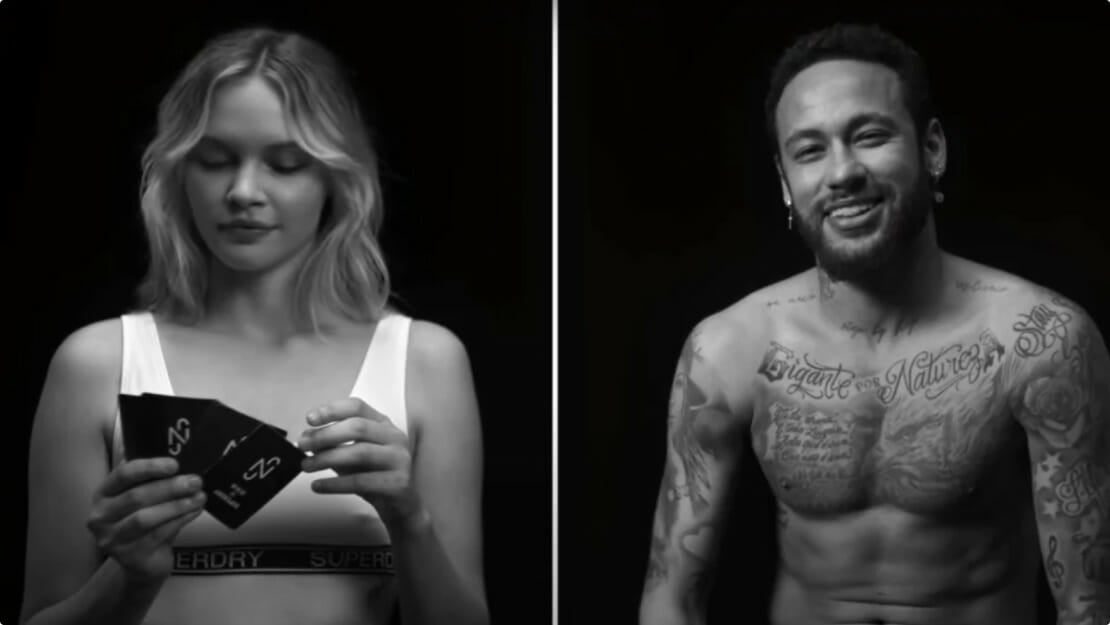
This is the “magical” effect of influencer marketing: When you see or hear about a product or company, you automatically associate it with a well-known person, such as a famous athlete or movie star, and vice versa.
But don’t be put off by thinking that if you’re not a big, well-known brand this type of marketing won’t work for you. You don’t have to pay a personality six or seven figures to have him or her promote your products.
In fact, the majority of influencers are not so notable and famous. Read on….
Tappan Collective + Amanda Frederickson
Have you heard of food blogger and mom Amanda Frederickson? Most people probably haven’t as she only just crossed 100,000 followers – a decent size, but not world famous.
Nonetheless, Tappan Collective, a company that helps emerging artists sell their artwork, reached out to partner with her.
She posted herself with one of the artworks created by them and the post received nearly 1,000 likes — and other customers in the comments exclaimed how much they loved Tappan:
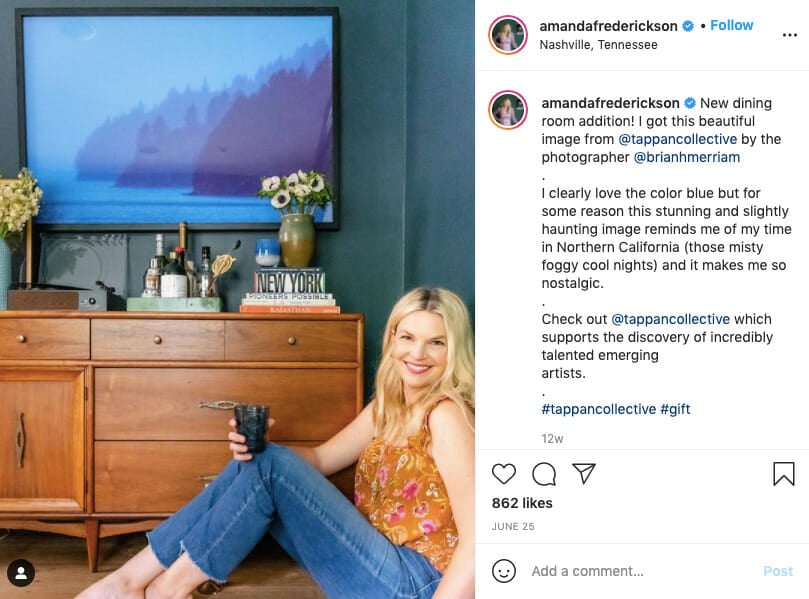
While this isn’t the crazy engagement you might get from a celebrity influencer, her following is quite loyal and therefore likely still drives sales.
67 Different Influencers + 67 Shades of Dior
Dior launched various new shades of makeup and used influencer marketing to give it a boost. They partnered with Buttermilk, a global influencer marketing agency, and located 67 different influencers across the globe that matched each of their 67 shades of Dior makeup:
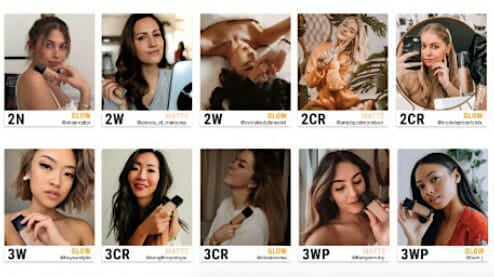
From there, they had each influencer post themselves using that foundation with the day corresponding to their foundation number (for example, the influencer using the first shade would post on day one whereas the influencer using the 67th shade would post on day 67).
The results:
- 67 Influencers 2.66m Audience Reach (+33%)
- 1.85m Impressions (+85%) 290 Content Created (+44%)
- 591k Engagements (+269%) 6.6%
- Engagement Rate (120%) 72% content was repurposed on owned channels and used as shoppable assets
Now, here’s how to evaluate influencers for your brand.
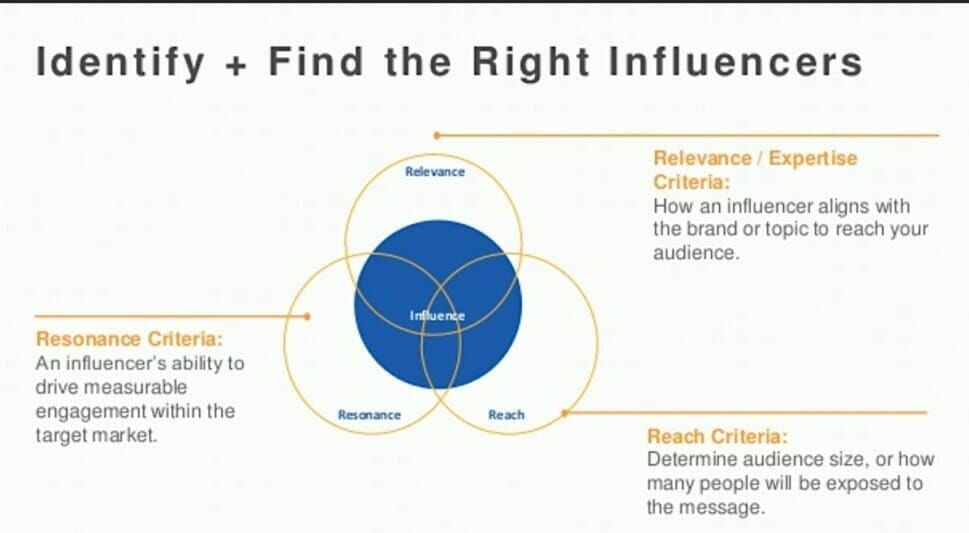
Social Media Reach
An influencer is only an influencer if they can actually influence the purchase decisions of others. Makes sense, right?
Simply put, the larger the reach, the larger the number of people who will see your product or service. An Instagram user with 1,500 followers may be able to generate some results, but an IG user with 150,000 followers can really push your message to your audience.
Of course, bigger is not always better. You should also take into consideration past engagement, as this helps you understand if the person’s audience truly listens to what they have to say:

Sticking with Instagram, you may find that a person with 15,000 followers receives an average of 500 likes on each update. Conversely, a person with 30,000 followers may only receive an average of 100 likes per update.
While the person with more followers will put your brand in front of more people, the update may not receive as much engagement. This is a balancing act with a trial and error component.
Depending on your budget, and the level of engagement per follower you want, you may want to look into a micro-influencer, or an influencer with a smaller (usually up to 10K) audience in a specific niche. Again, a macro-influencer may promote you to millions, but how many are really listening? Are they really willing to engage the way someone specifically in your niche would?
Influencer Rates
How much influencers charge:
- Nano-influencers (1,000-10,000 followers): $10–$100 per post
- Micro-influencers (10,001-50,000 followers): $100–$500 per post
- Mid-tier influencers (50,001-500,000 followers): $500–$5,000 per post
- Macro-influencers (500,001-1,000,000 followers): $5,000–$10,000 per post
- Mega-influencers (1,000,001 plus followers): $10,000+ per post
Creating a Database
Rather than just randomly reaching out to various influencers, create a database in Google Drive or Docs with the most promising influencers.
Here are the main things you should add to your database for every influencer that you research:
- Name
- Niche
- Fan base size
- Social channels (and links to them)
- Strong points
- Weak points
- Contact info
- Observations: write down their peculiarities (tend to use video a lot, has a great sense of humor, has lots of ads, our competition has him/her under contract, etc.)
Influencer Platforms
Influencer marketing platforms provide searchable databases of influencers to help brands find a perfect match for their campaign.
The benefit of using such a platform is that much of the work is already done for you. The influencers come pre-vetted and their profiles offer lots of information regarding their niche, activity on different channels, fan base count, etc.
More on this in CHAPTER 7: Tools to Find Influencers and Track Your Marketing Campaigns
Chapter 4: 5 Hacks to Start a Conversation with an Influencer
Influencers and industry experts are swamped with senseless offers, advertising, and spam. People ask them to share, to help, and to advise. This is why they tend to ignore most of the messages they receive without even reading them.
The best approach is to do the influencer a favor first, not asking them for a favor, which will help them notice your message among all the others that are doing the opposite.
Once you strike up a conversation, you’ll be able to start collaborating on some projects and building long-lasting relationships.
Here are five ways to start a conversation with an influencer you’d like to work with.
1) Conduct an Expert Interview
Here are two undeniable reasons for this approach:
- People love sharing their experience and discussing things they’re passionate about or they’ve learned.
- Because influencers don’t have a lot of time, your offer to interview them as an expert is a great opportunity for them with very little work on their part.
It’s best if you pitch some large publications and have a publishing contract or agreement in place first before asking experts to contribute. Without an agreement, you may end up unable to find an appropriate platform for publishing your interview. And asking influencers to take part in articles that never go live isn’t something that helps build strong relationships.
So tell the influencer your idea and where you’re going to publish it. They are usually more than happy to contribute. Once your interview goes live, it will be much easier to ask your influencer for a favor or discuss some other ways to collaborate.
How to Implement
To find exciting questions for your interview, I suggest using BuzzSumo’s question analyzer:
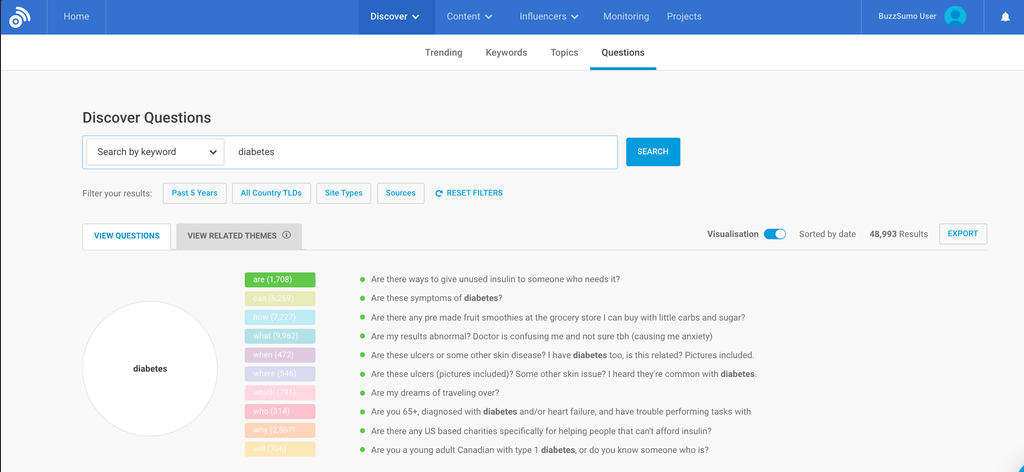
It gathers millions of questions from Q&A sites, e-commerce sites, and forums like Quora, Reddit, and Amazon Q&A.
Try searching for your main idea for the interview, look through the list, and grab the most exciting questions you’d like to ask your subject. Then:
- Decide where you are going to publish this post (on your own blog or another platform).
- Add it to your editorial calendar or make an agreement with the other platform.
- Find influencers by using one of the tools in chapter 7, by searching LinkedIn, Facebook and Twitter communities, and by finding lists of industry experts on Google.
- Add influencers on LinkedIn, Facebook and Twitter, and follow them on other social platforms to make it easier to reach out or follow up in future.
- Start reaching out to influencers! Send a personalized email explaining who you are, what you want, and what your idea is.
I believe strongly that no one is so busy that they have no time to write “thanks, not interested.” So don’t give up after sending a single email and not getting a reply.
Follow up at least two times if there is no response for 3-4 business days, and then try to reach out via LinkedIn/Facebook/Twitter, or the contact form on their site. But remember, don’t be too pushy and don’t write too often. Stop after 2-3 messages.
The main idea of this approach is to offer a unique and exciting idea so that the influencer notices you in the email chaos.
2) Don’t Ask for a Favor; Offer a Favor
As I said earlier, influencers are swamped with messages from people asking them for a favor. If they helped everyone, they wouldn’t have time for anything else! So that’s why I offer the opposite approach: do a favor for them first.
How to Implement
What kind of favors can you do for an influencer? Here are few ideas:
- Comment on their blog post
- Share their blog post
- Review their book
- Endorse their skills on LinkedIn
- Find and report a (significant) error on their blog
These ideas are easy to implement if you’re already a part of the professional community. If you want to find an influencer in your niche, you should always be in the community commenting and sharing influencers’ social media posts, their blog posts, and their articles on the leading publications in your niche.
These steps will help let influencers know about you so that your name rings a bell when they see it in their inboxes.
The most important thing here is to find the right words to start a conversation so that it doesn’t look like:
“Hey Ben, I reviewed your e-book. Now I want you to share my article in return.”
The better variant would be:
“Hey Ben. Recently I was reviewing your e-book on Amazon and I came up with a brilliant idea for a blog post that would complement your book. Could you please take a look at it and share your opinion?”
3) Create a Personalized Pitch
Influencers usually have their own blogs, and pitching a high-quality article is a great way to start a relationship. If your idea is good and unique and your pitch doesn’t look like spam, you have a great chance of getting noticed by the influencer.
While the wonderful idea for the guest post is up to you, I’ll give you some tips on how to create a personalized pitch.
How to Implement
A few years ago, merely adding the recipient’s name to the subject line was an effective way to improve your open rate. These days, you’ll have to put in more effort to personalize your message than just writing the person’s name.
In fact, studies show that only gives you a 2% lift.
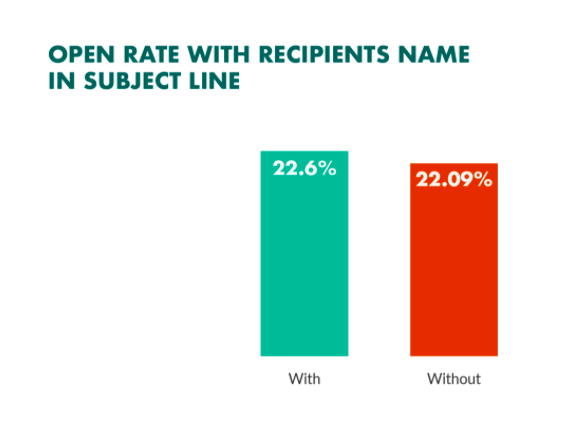
Some examples are:
- “Hey, I found this article on your blog, and I think I could develop this topic in another direction…”
- “I found an article about backlink building strategies in 2017 on your blog. I’d like to write an updated article on the same topic…”
- “I’ve found that articles about content marketing are the most shareable on your blog, so I would like to offer…”
Use a tool like Serpstat or BuzzSumo to find the most shareable content on any blog or website:
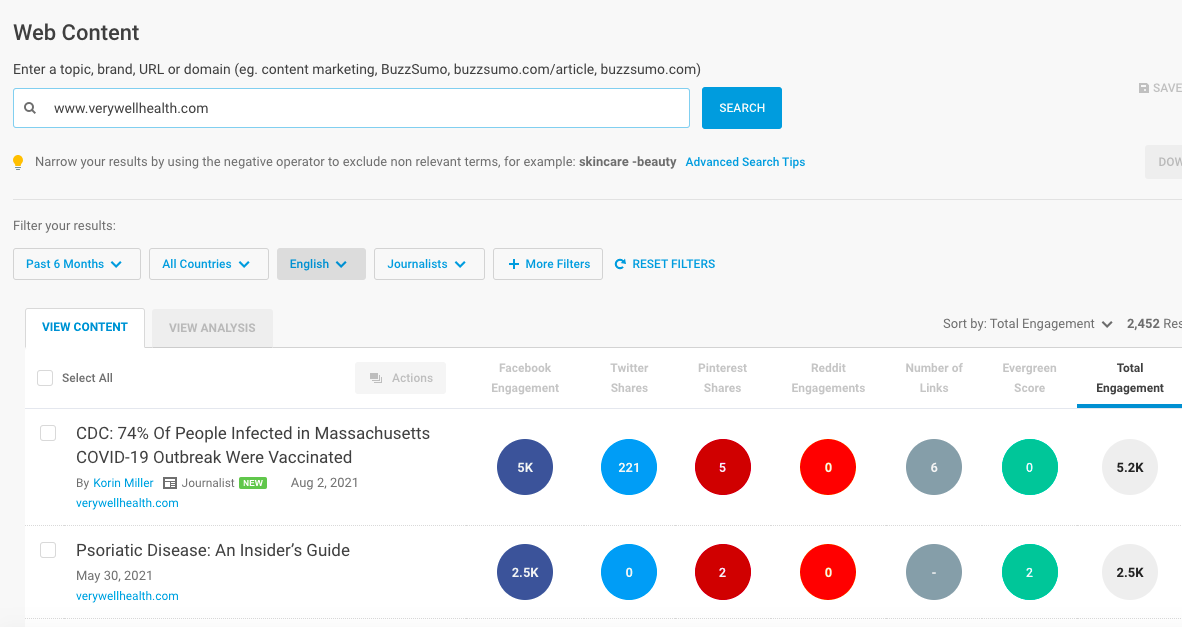
The ideas for personalization are endless – you just need to use your imagination a little. At the same time, you should keep your pitch as brief as possible.
In fact, your pitch email should consist of a short introduction, a personal note, suggested topics for a guest post, and several writing samples (if necessary). So cut out the fluff and get straight to the point.
Related Content:
* How to Use Personalization to Increase the Impact of Email Marketing
* How to Get More Responses From Your Cold Emails
* 10 Best Cold Emailing Tools to Help You Quickly Close Sales Deals
4) Ask for a Piece of Advice
As I said earlier, people love sharing their experiences, but most influencers are too busy to talk to strangers and help newbies.
That said, if you ask meaningful questions, some of them will respond, and it’s a great way to strike up a conversation and get the chance to collaborate in the future. Micro-influencers are particularly likely to respond.
How to Implement
- Write down several complex or difficult issues that only an experienced person could answer. Never ask something that everyone can find on Google! If you can’t think of anything, try looking on Quora or other relevant forums.
- Send a brief and polite message asking the influencer if they could help you out by answering a quick question(s).
When Eric Siu, CEO of Single Grain and founder of Growth Everywhere, was first starting out, he used this exact strategy to learn from Neil Patel. Not only did he learn from an expert, but now they co-host the popular Marketing School podcast.
From an interview with Neil on Growth Everywhere:
“In the course of time that led up to Neil deciding to take Eric on as a mentee, Eric was constantly messaging Neil with short, to-the-point emails that contained sophisticated, non-basic questions – asking just one question at a time, making it easier for Neil to reply.
At the same time that Eric was asking him questions to help his business, he was also trying to help Neil’s. For example, he gave Neil suggestions on ads by comparing his ads to someone else’s and showing him the statistics.”
5) Mention the Influencer in Your Content
The last approach I’m going to cover is mentioning influencers in your blog posts. In fact, you’re helping the influencer promote his/her blog, personal brand, or service, so of course, he/she would be happy to take a look at this post and share some feedback.
How to Implement
- Find influencers who are interested in your topic. To do this, you can use special tools, follow LinkedIn/Facebook communities, and follow influencers on Twitter.
- Find a way to mention them in your blog post. It could be a quote, a link to his/her post or research.
- Email the influencer and ask them to take a look at your post and share their feedback. If the post is good, an influencer can share it with his/her audience, and you’ll have something to talk about.
The best article on this kind of outreach I’ve seen is this one called “I Just Deleted Your Outreach Email Without Reading. And NO, I Don’t Feel Sorry.”
Chapter 5: How to Reinforce Your Customer Acquisition Strategy with Influencer Marketing
Collaborating with influencers to reinforce your customer acquisition strategy is probably the most cost-effective way to gain new customers.
But make sure to find relevant influencers in your niche for the success of your campaign.
Let’s take a look at some winning influencer marketing tactics to help you create a robust customer acquisition strategy.
1) Get Influencers to Promote Your Brand’s Story
Stories are the best way to build an emotional connection with people, so you can ask your influencers to share your brand’s stories with their social media followers in ways that will appeal to them. But why do you need an influencer to become a storyteller for your brand?
Influencers are known for their creativity and authenticity, so when they present your stories to their followers, it can do wonders for your customer acquisition strategy.
For example, Amber Fillerup is a fashion influencer and an expert storyteller on Instagram with 1.3 million followers. Popular brands like Urban Outfitters and Nordstrom have often teamed up with her to promote their brands’ stories.
In the post below, she is promoting a product from Skatie Swimwear. This post is effective in that it is selling the product (with nearly 30,000 likes) yet still follows the influencer’s typical posting style.
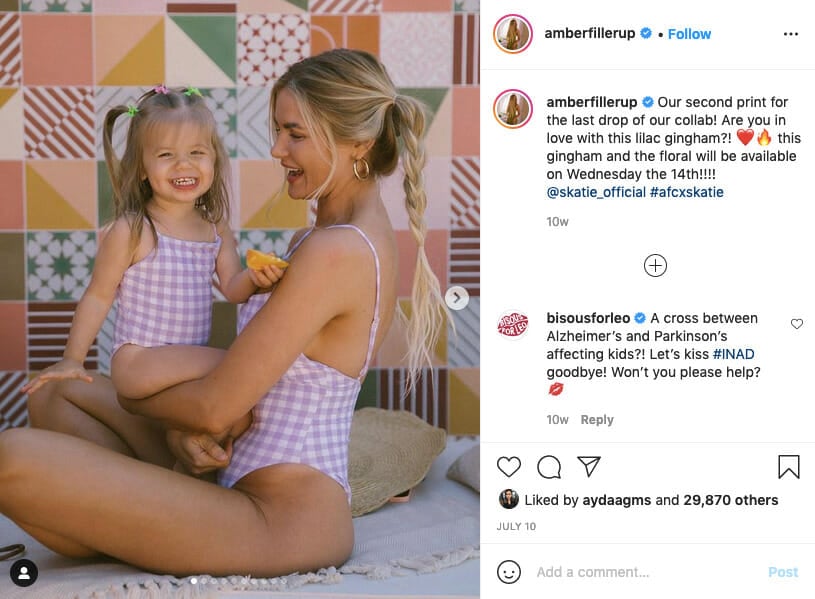
2) Get Influencers to Collaborate on Giveaways and Contests
When done correctly, giveaways or contests will definitely draw new customers to your brand because it’s always exciting to win a prize, free of cost. And when you collaborate with influencers to run contests or giveaways, you can reach a wider audience which may not have been possible otherwise.
For example:
- dbrand partnered up with Marques Brownlee and his YouTube channel MKBHD for a $1,000 smartphone giveaway. The giveaway was quite successful with the video earning 1.6 million views and generating plenty of buzz on social media.
- Kcstauffer also has several excellent examples of how you can run a successful influencer giveaway. Recently, she ran a giveaway for the brand Thatsit Bars where they offered a $1,000 Costco giveaway. This post alone generated over 126,000 likes and significant engagement for the brand.
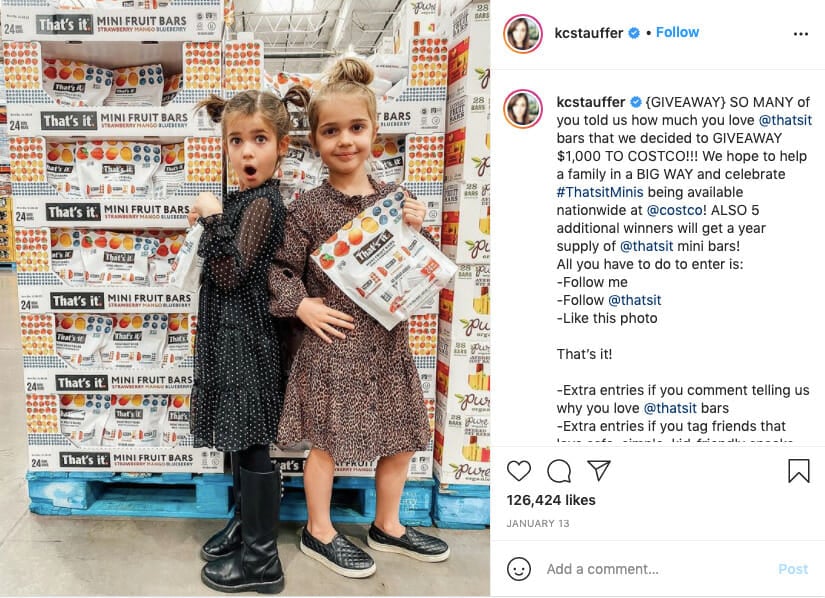
Just make sure that the instructions to enter the contest are clear and so are the winning criteria. Of course, you need to also make sure that you’re offering something valuable so that people want to participate.
3) Get Influencers to Use Campaign-Specific Hashtags
The key to getting discovered by relevant audiences and increasing brand awareness is to use the right hashtags, but remember that it takes time, effort, and extensive research to find relevant ones. Ensure that they are a mix of common and unique ones and encourage your influencers to use this successful combination of hashtags in their posts.
For example, Cadbury, a chocolate bar company, works with micro-influencers to promote their product and gain new customers:
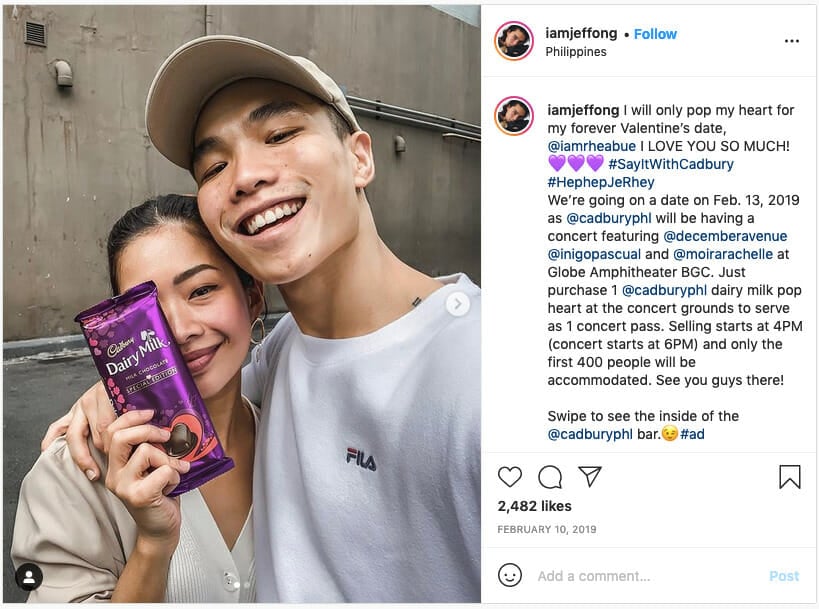
As you can see here, the brand uses specific hashtags and they’ve asked the influencer to use them too (#SayItWithCadbury).
Just like Cadbury, you can also promote your products by using specific and relevant hashtags in your campaigns. One way of collaborating with micro-influencers is to send them free samples of your products and ask them to review and/or promote them on social networks.
4) Get Influencers to Write Honest Reviews
To further strengthen and support your customer acquisition strategy, ask your influencers to write and share honest reviews about your products. Genuine feedback never fails to attract new customers.
User reviews and testimonials are even more important when you are a fairly new brand in the industry. In such cases, a positive review from an influencer whom customers trust can speak volumes about your brand and it’s value.
So collaborate and ask relevant influencers to give you their honest feedback of your products or services and ask them to share their experience with your brand on their social accounts. These tactics will surely help you win the trust of new customers.
For example, when the Sony ZV1 was released, there were plenty of influencers that did reviews of it. One was DPReview TV, which has over 300,000 followers and that video alone earned 131,000 views:
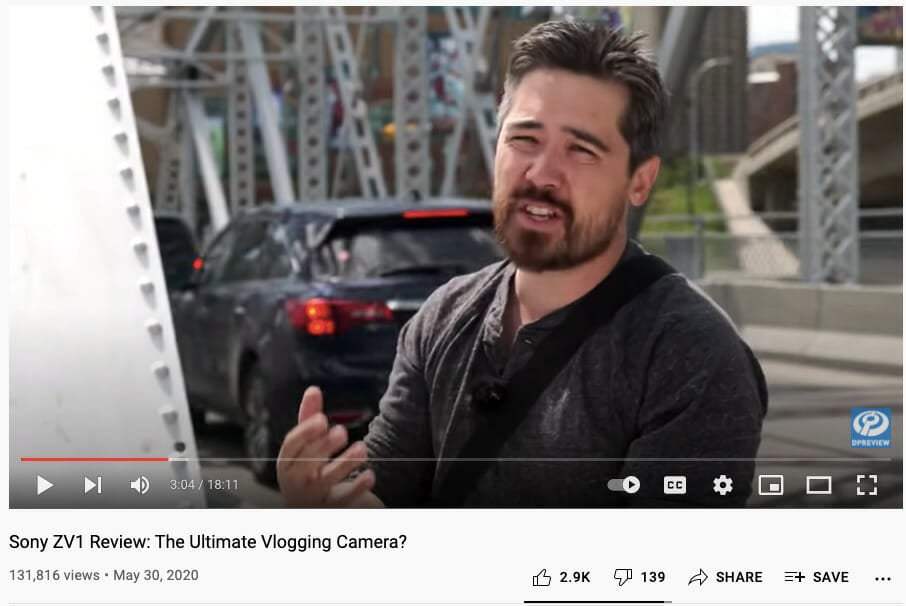
5) Get Influencers and Common Users to Leverage UGC
Leveraging user-generated content (UGC) is one of the most successful and powerful tactics to gain new customers.
For this tactic to work, you need to first establish and build connections with your influencers and then leverage their trustworthiness and reliability to position the image of your brand on social media.
This is exactly what GoPro did to create a loyal following. They encouraged users to film their adventures and submit them for a million dollar contest. As a result, they’ve gotten over three million posts with the hashtag #goprohero and plenty of micro influencers to join in the fun.
For example, micro influencer Matthias Weger won two of the #goprohero Million Dollar Challenges and his post has earned over 300,000 views:
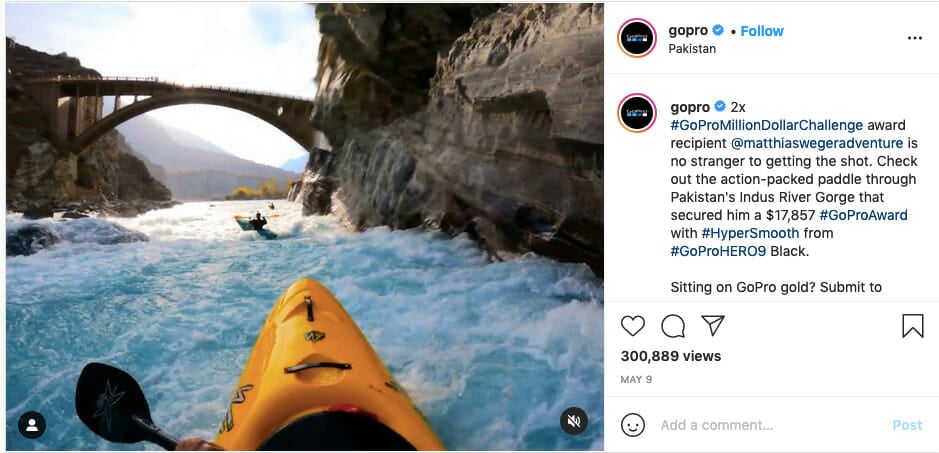
Chapter 6: SEO: How to Build Links with Influencer Outreach
Before I show you how to boost SEO with influencer marketing, I’ll first explain why it works.
1) How Influencer Marketing Can Boost Your SEO
Here are four ways that influencer marketing can boost your brand’s SEO.
- Build Brand Awareness. When you partner with established industry players, you can shorten the process of building awareness for your new brand. It’s no surprise that about 67% of marketers promote content with the help of influencers, particularly those who have a loyal following of hundreds of thousands of people.
- Get Backlinks. When you reach a larger audience through influencer marketing, you also get significantly more opportunities to build backlinks. Links are one of the most important ranking factors that Google uses in search. When you partner with bloggers through guest posting, product reviews or other types of collaboration, you’re almost always guaranteed a new link back to your site.
- Gain Social Media Followers. SEO experts like to argue over whether social media marketing has a direct impact on PageRank in search engines. Either way, most people agree that a strong social media presence typically correlates with stronger SEO. When your business engages with a new social audience, it unlocks the potential for more followers and engagement. This can lead to more site traffic, backlinks and other factors that improve SEO.
- Create More Organic Content. The more content you create through influencer marketing, the more opportunities you have for your brand to rank in Google search results. Say your business is new and your domain authority isn’t good enough to rank well. If you write a guest post on a big site, this content will likely rank much better in search while spreading the word about your brand.
The same goes when you work with a YouTube influencer (more on this in Chapter 8: How to Work with YouTube Influencers to Grow Your Brand) to promote your brand. It’s a big opportunity to rank better in Google Video Search and regular organic results:
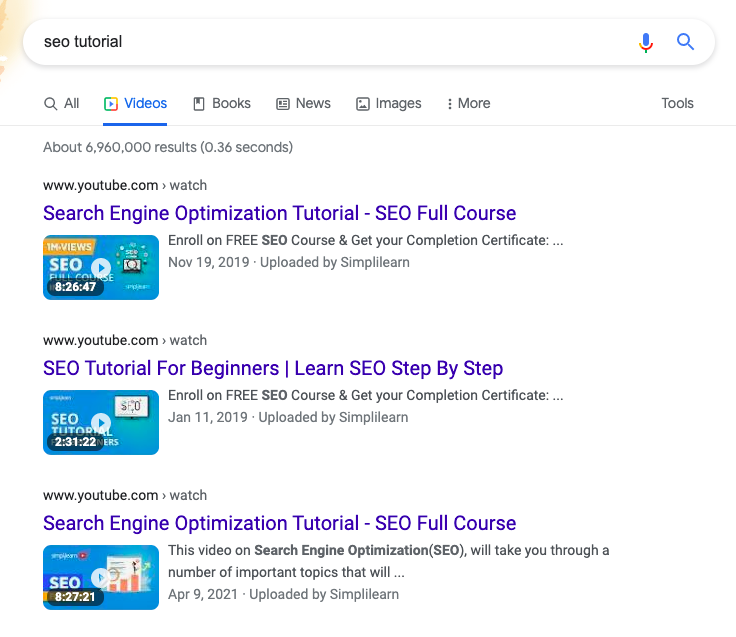
2) Strategies for Working with Influencers to Build Links
There are a lot of different ways to collaborate with influencers. Here are a few strategies you should focus on if building links is your main goal:
Link-Building Strategy 1: Product or Site Reviews
When looking for influencers to review your product, make sure you check their domain authority. Bloggers who offer review opportunities tend to link back to a lot of different sites. This could negatively impact their domain authority if they’re linking to a lot of low-quality sites. You don’t want that kind of link juice for your website.
The more domain authority a site has, the more valuable their links will be for your SEO.
You can use a number of tools to compare their domain authority to yours. Moz’s Link Explorer, for example, offers a free domain authority score based on the potential of a domain to rank in search results:
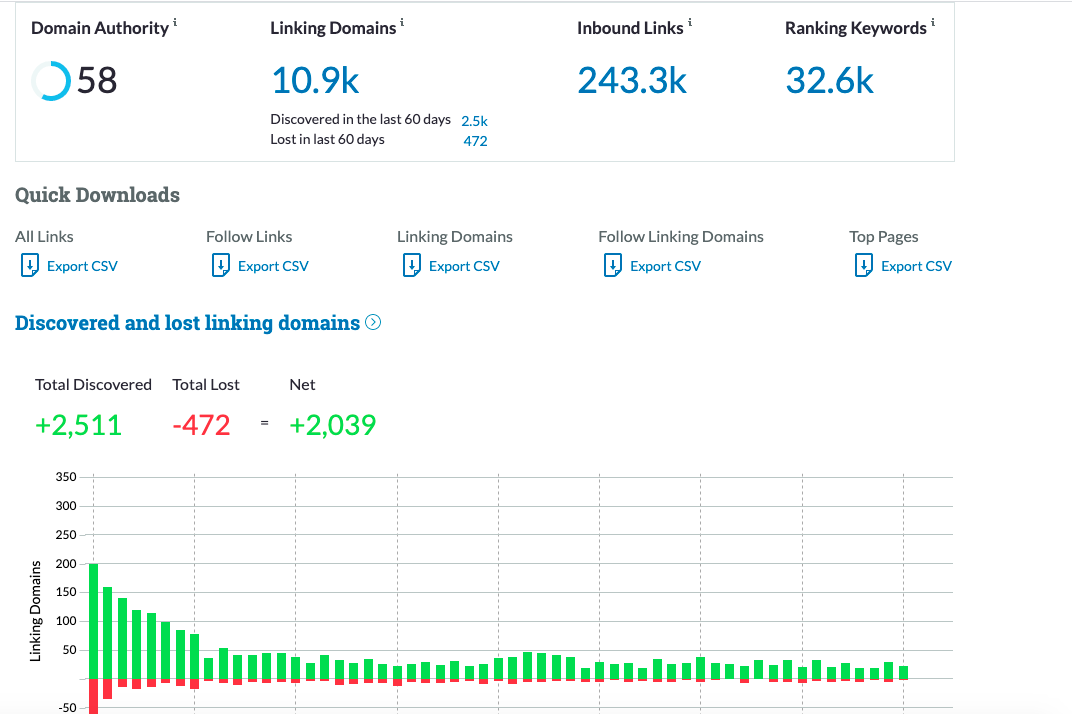
Link-Building Strategy 2: Guest Posting
Guest posting is a great way to grow links while collaborating with another site, free of charge. As with review sites, you should target domains that have comparable or better domain authority.
It’s easy to find guest posting opportunities on sites that have published submission guidelines. Just use search queries like these to get started:
- [Niche keyword] “write for us”
- [Niche keyword] “contributor guidelines”
- [Niche keyword] “submit a guest post”
- [Niche keyword] “guest post”
- [Niche keyword] “become a contributor”
Read the fine print of their guidelines and try to target blogs that allow you a dofollow link back to your website.
Link-Building Strategy 3: Discount Code for Their Readers
If you aren’t prepared to give away free products to work with influencers, a discount code should be enough to start working with them and reaching a new audience.
Dealspotr can help with this. It’s a platform where brands can promote their product deals and connect with blogging influencers. You provide the coupons and influencers will share them with their audience.
Link-Building Strategy 4: Mention the Influencer
People love to link back to and share content that features them. You can benefit from this by regularly creating blog content that mentions or features other influencers.
Roundup posts are a great way to do this and DataBox is an expert at this:
You could also quote an influencer or feature their business/product in your content.
After your content is published, reach out to them by e-mail (you can find their e-mail address with Hunter) to let them know they’re mentioned. Provide a link to the content so they can easily share it.
Link-Building Strategy 5: Contribute Your Expertise
If you take a closer look at some of the best content on the web, you’ll almost always see that it was the result of collaboration between industry figures.
For example, Neil Patel and Eric Siu collaborated to create a daily Marketing School podcast:
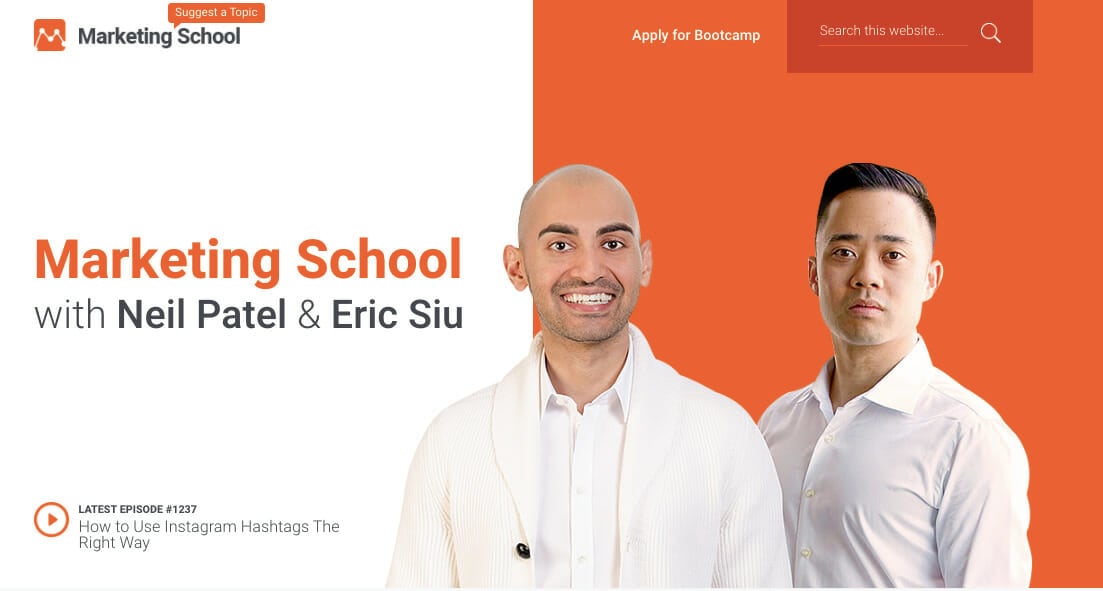
If you have some industry data that another industry player could analyze and use, or just helpful knowledge on a topic to improve their content, propose a collaboration.
Link-Building Strategy 6: Content Optimization
Content optimization is content that’s been carefully optimized performs better in the SERPs. It ranks higher and for a bigger spread of search terms.
That means more eyes on your content and a greater chance that others will link to it from their own content. Not only that, but the work involved on your side to score any extra links that may come your way is minimal.
Related Content:
* 4 Ways to Signal to Google that You’re an Expert Content Creator
* The Ultimate Guide to Link Building with Content for SEO
* 9 Effective SEO Techniques to Drive Organic Traffic in 2023
Chapter 7: Tools to Find Influencers and Track Your Marketing Campaigns
If you’ve gotten this far in this post (hurray!), you now fully understand the power of influencer marketing. But what good is this power if you aren’t tracking it?
Tracking your influencer marketing campaigns is an important strategy to help you make informed marketing choices to drive better ROI.
The one-dimensional insights you gather from UTM codes and social impressions simply aren’t enough for many brands to maximize the value of influencer marketing.
Here are the average engagement rate benchmarks across four key platforms (Instagram, YouTube, Facebook, Twitter) and influencer follower size (nano, micro, medium, mega):
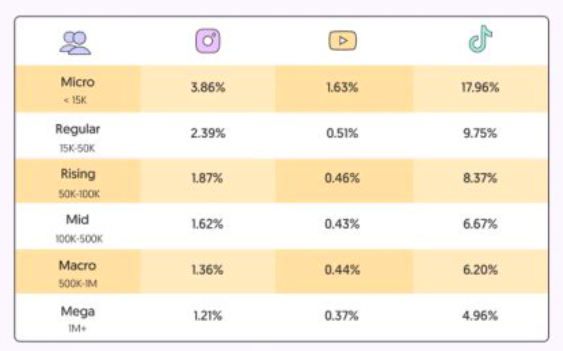
Statistics like these offer an industry snapshot, but how do you make sure that you manage the same level of success for your brand? Consider trying one of these advanced tracking tools and see the benefits for yourself.
Top Tools to Find Influencers and Track Your Marketing Efforts
1) Traackr
Just like the name implies, Traackr is one of the top tools out there to help you build an effective influencer marketing campaign and track it. Traackr was built with the idea of helping brands manage their relationships with influencers, but it also comes with a host of features that help you monitor the effectiveness of your campaigns.
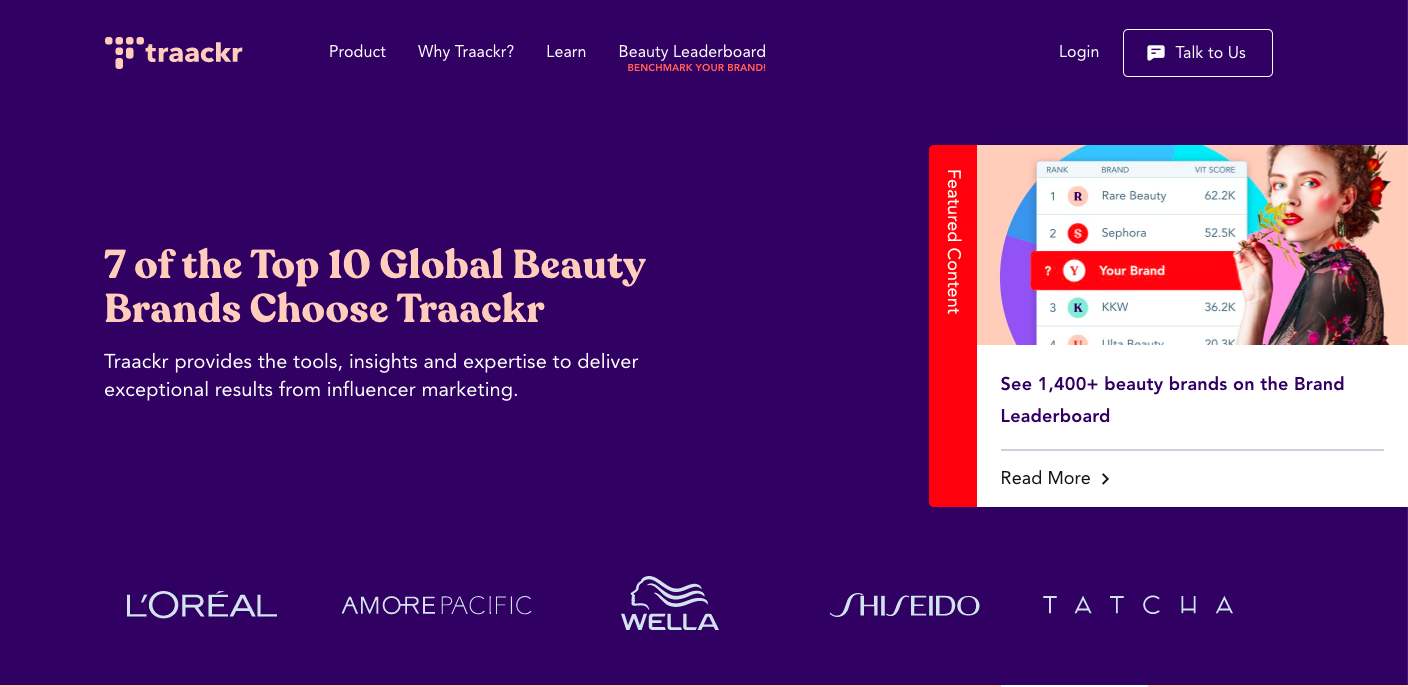
How It Works
Upload your list of existing contacts and use Traackr to search for the best possible influencers. Traackr helps you validate your influencers by offering in-depth metrics about who they are and where they’re active on the web.
Next, you can tier and organize your influencers into meaningful groups based on their niche, team members they’re relevant to, which projects they’re associated with, etc.
Traackr analytics features allow you to:
- Set a benchmark for your brand’s current influence in the market so you know your starting point for improvement. Compare your share of influencers against competitors to set a baseline.
- Get a complete picture of how each influencer marketing initiative is performing (content, platform, etc.). Track changes in mentions and engagement with new influencers.
- Analyze your investment and influencer results together to determine who is the most effective at driving engagement for your brand.
- Set up reports to track fulfillment and compliance when you ask influencers to help promote your brand.
The main pain point Traackr aims to address is eliminating cross-functional conflicts when you work with a large team and a lot of influencers.
Pricing
Traackr does not list any set pricing, and instead asks you to contact them directly for a quote. Discussions around the Internet suggest that they are not cheap. That said, whatever they do charge will be customized to your influencer marketing needs, so you won’t have to pay for features you don’t use.
2) Dealspotr Marketplace
The Dealspotr Marketplace is a free influencer marketing platform that combines the benefits of a promo code website with a CRM-type management system to track your influencer marketing campaigns. You can add exclusive codes to the platform, browse Dealspotr’s database of micro-influencers to enlist in promoting these codes and your product, and track everything from one comprehensive dashboard.
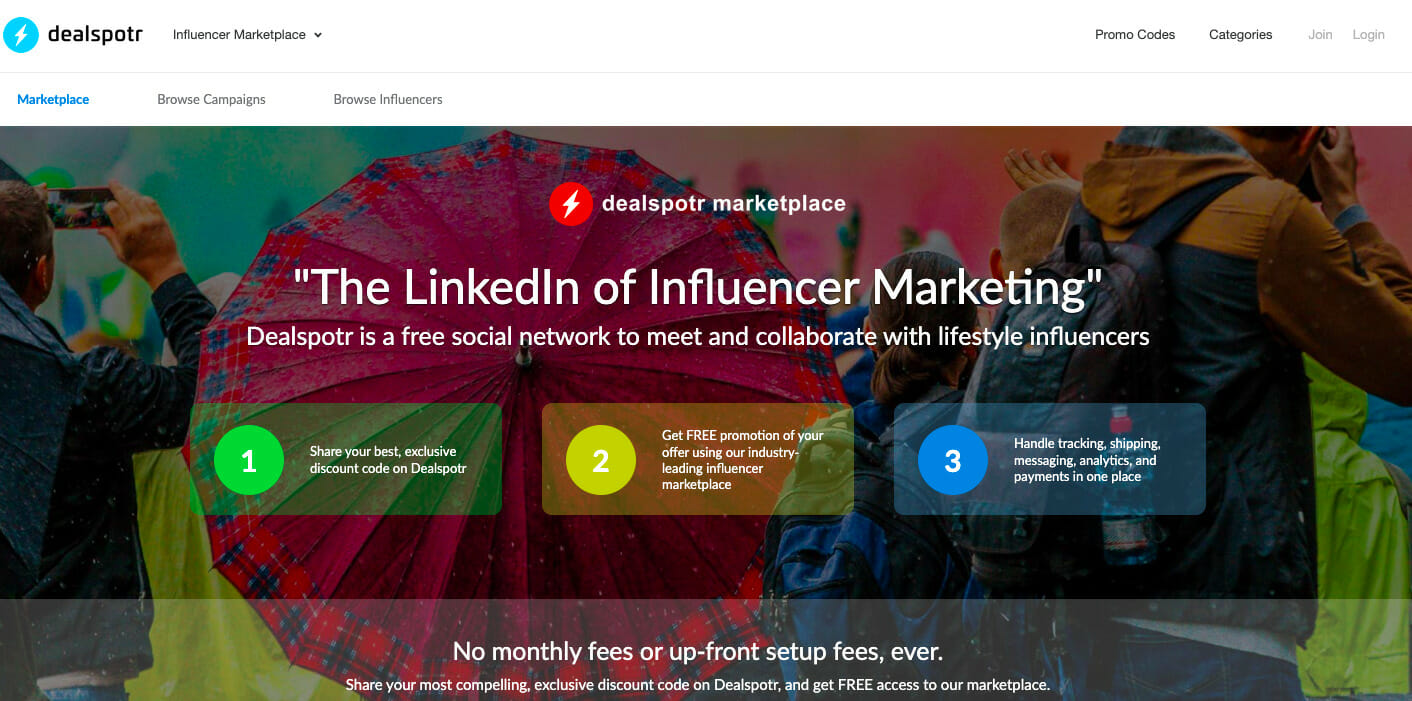
How It Works
Since Dealspotr functions as a hybrid promo code database and influencer marketing platform, you’ll have access to two basic types of marketing capabilities:
- Promoting your promo code(s) on the web
- Partnering with influencers to run sponsored content about your brand/store
Much like posting a job on LinkedIn, Dealspotr allows you to create a sponsored campaign that is visible to their network of over 4,000 micro-influencers.
Here are some key features:
- Pre-calculated Influencer Rate. When running an influencer marketing campaign, a lot of time can be spent negotiating with influencers on their rates. In the Dealspotr Marketplace, each influencer is given an Influence Score, which is calculated by an algorithm. This score determines the fee that an influencer is paid, and is designed to combat these fake followers and overinflated influencer rates.
- Manage All Your Campaigns from One Dashboard. When you create an influencer marketing campaign in the Marketplace, you’ll have access to a full dashboard – your hub for everything you need in order to track your campaign. You’ll be able to see pending applications from influencers who want to work with you and track the status of each one. You’ll be able to track invites you’ve sent out as well.
- Track Clicks and Conversions. One of the hardest things to track with an influencer marketing campaign is the ROI. It can be a hard number to quantify and requires a lot of analytical data and processing. The Dealspotr Marketplace automatically tracks clicks and sales for each influencer you work with. The platform’s tracking technology integrates with Shopify, Magento, WooCommerce, and other popular e-commerce platforms, and gives updates on clicks and conversions in real-time.
Pricing
The Dealspotr Marketplace is completely free for brands to use. Any type of “fee” is baked right into the exposed influencer’s rate, so what you see is what you pay.
3) Klear
Klear is first and foremost a place to search for and find influencers to work with, but it has also become a sophisticated platform to manage and track your campaigns as well.
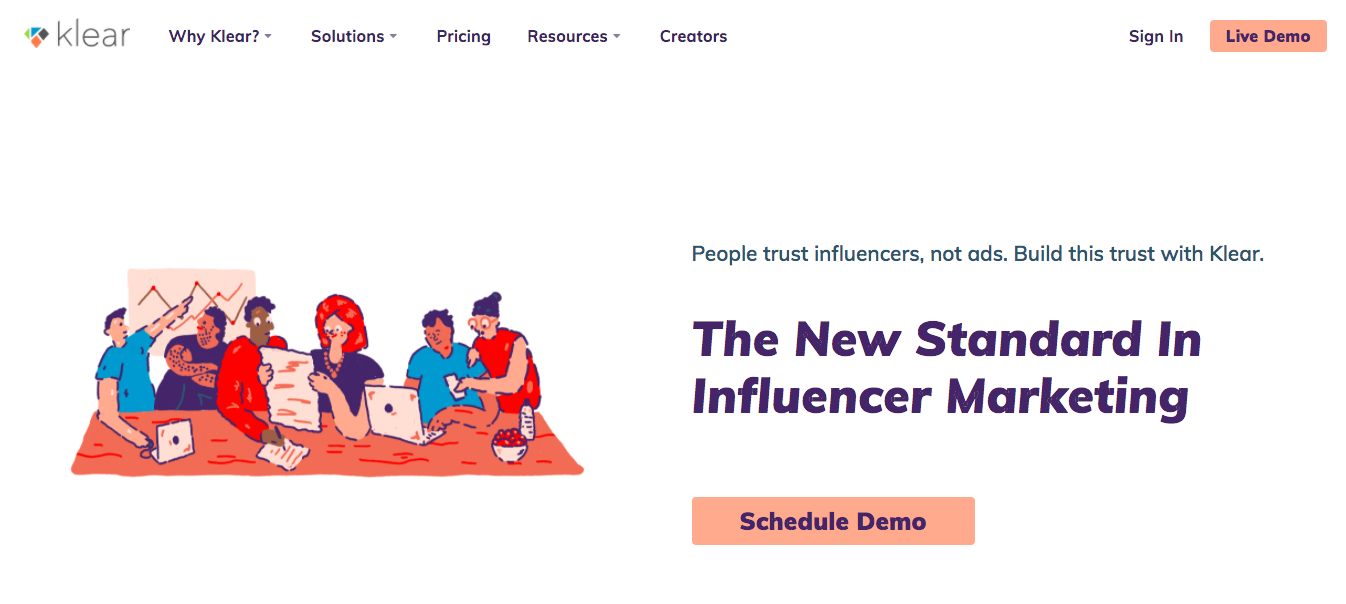
How It Works
Klear is fully equipped to help you find, analyze, manage and monitor your influencers. Here are some key features:
- Find and Analyze Influencers. Klear offers a database of 900 million influencer profiles with historical data. You can browse or search through more than 60,000 categories based on skill, location, platform, and more.
- Manage Campaigns. Klear offers a built-in CRM to help you manage your influencer campaigns. It was designed specifically for influencer marketing so you can focus on key insights that matter most, like hashtag mentions for your campaigns, influence, reach, and total fans for each influencer.
- Monitoring Performance. With Klear’s Performance Report, you’ll see hard data for your influencer campaign key performance indicators. All these metrics are tracked in real-time, keeping you up-to-date on your true reach. You can also create your own custom reports to visualize the impact of your influencer marketing efforts.
Pricing
Klear does not list any set pricing, and instead asks you to contact them directly for a quote.
4) GroupHigh
GroupHigh is an all-in-one tool to help you find bloggers and social influencers, manage your relationships with them, and measure the impact of the content that they create for your brand or agency.
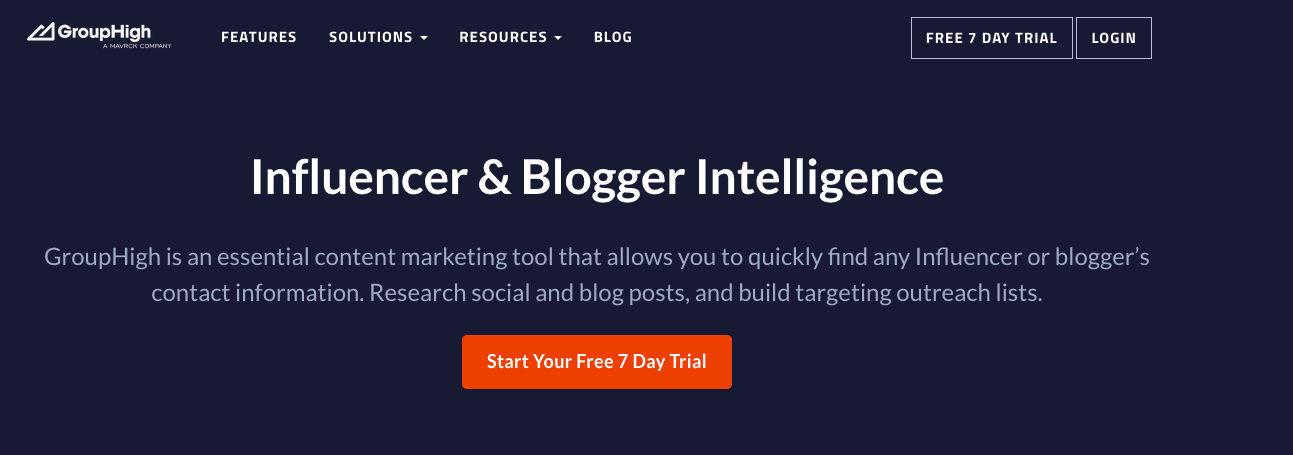
How It Works
GroupHigh has quite a few features that will help you launch, track and improve your influencer marketing campaigns:
- Blog Search Engine. GroupHigh offers a database of 50 million websites you can search to find the right influencer to fit your brand message.
- Website Research. If you have spreadsheets from your old influencer outreach efforts, you can upload the URLs to GroupHigh to get deeper insights into their social footprint, traffic, SEO and other key website metrics. Use this information to track key blogging influencers and make informed decisions about which to work with.
- Influencer CRM. GroupHigh’s Influencer CRM offers some advanced features to help you track your influencers and manage your relationships with them. Use folders and lists to organize them based on performance, affinity, niche, and other metrics. Then, filter down based on recent content, followers, keywords, etc.
- Blog and Social Content. GroupHigh makes it easy to collect all your brand or campaign mentions related to your influencer marketing efforts. It scours the web to find blog posts, Tweets, Instagram posts, and YouTube videos associated with your campaign so you can see the results of your efforts.
- Content & Engagement Reporting. Lastly, track the performance of your campaigns as a whole and by individual influencers with Engagement Reporting. See which content is driving the most engagement, mentions, conversions, impressions, etc. The report will also rank your influencers to give you insights and encourage them to share and post.
Pricing
GroupHigh doesn’t list any pricing options on their website — you’ll need to reach out to them for a quote.
Third-party sources around the web say full-access can range between $5,000-$9,000, making it a pricey option to track your influencer marketing campaigns. But it’s likely that GroupHigh customizes their pricing to the needs of each user so you can focus on the features that matter to you most.
5) Onalytica
Onalytica is an influencer relationship management software to help you find, reach out to, and track your influencers. It offers an impressive amount of data to help you track and measure your campaigns.
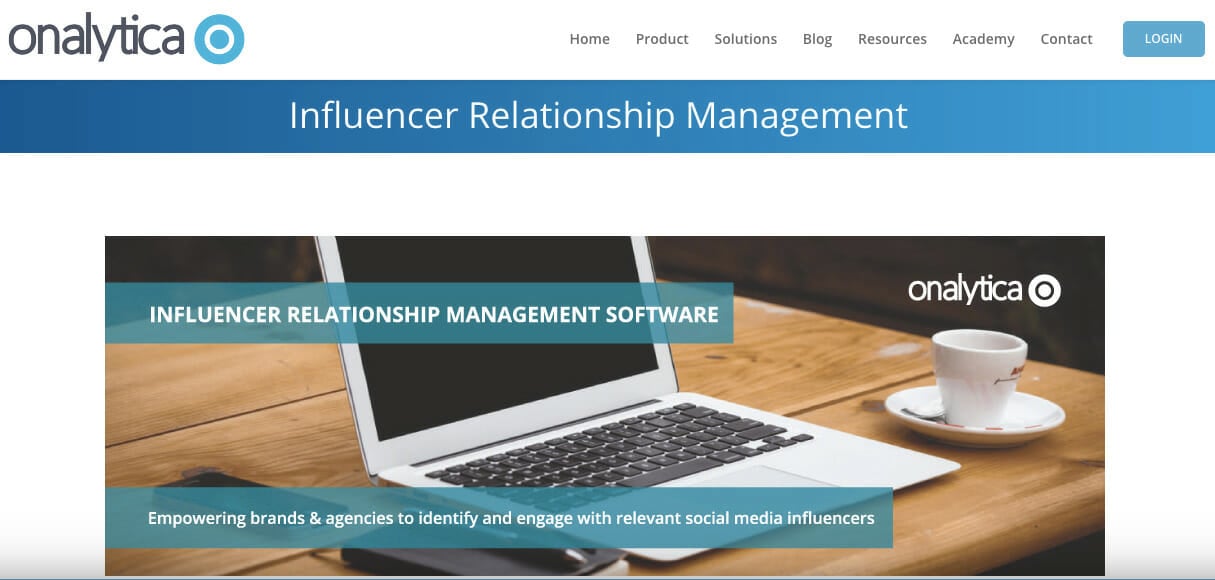
How It Works
Onalytica provides influencer discovery software, a relationship management platform, and professional services to help you optimize your campaigns.
If tracking features are what you’re interested in, then check out their Influencer Relationship Management (IRM) platform. It offers:
- Customizable Dashboards. See and analyze your influencers all in one place. Customizable dashboards offer a snapshot of top influencers and their conversations, along with whatever other charts you want to see.
- b) A Real-time Influencer Feed. Here you can keep track of key market influencers and see real-time reports of their social conversations. You can set this feed to focus on certain influencers, topics, time periods or social channels.
- Influencer Profiles. If an influencer catches your eye, you can visit their profile to get more insights into what they talk about online and who they’re connected to. This information can help you make your engagements more relevant.
- Content Sharing Opportunities. Here you can upload your white papers, case studies and other marketing content, and Onalytica will automatically alert you when that content becomes relevant to an influencer.
- E-mail Topic Alerts. Receive automatic e-mails when opportunities to influence come up, such as one of your target influencers mentions a topic that you can share with your audience to further nurture your relationship with them.
- Insights & Measurement Reporting. Lastly, Onalytica offers powerful analysis features including 12-months’ worth of historical data on your influencers, their social discussions, and your relationship with them. You get access to key insights such as volume trends, share of voice, and share of reach to help you monitor and analyze the impact of your efforts.
Pricing
Onalytica doesn’t list any pricing options on their website — you’ll need to reach out to them for a quote.
From reviews on the web, it seems that the platform is a good fit for medium- to large-sized companies who can customize their plan to fit their particular needs.
BONUS: 6 Additional Tools for Influencer Outreach
Here are a few more helpful influencer marketing tools that you can use to build backlinks and improve SEO:
BuzzSumo
BuzzSumo is a great tool to find both blogging and social influencers. Use it to search for keywords related to your niche and BuzzSumo will show you the most popular content on the topic.
You can target the authors of that content and maybe even collaborate with them or guest post on their site to build brand reach.
If you’re looking for social influencers, click the “View Top Sharers” button next to the content (on the very far right) where you’ll see powerful social users who like to share content related to your niche. Or you can go straight to the “Influencers” tab on the top menu to search by author or topic:
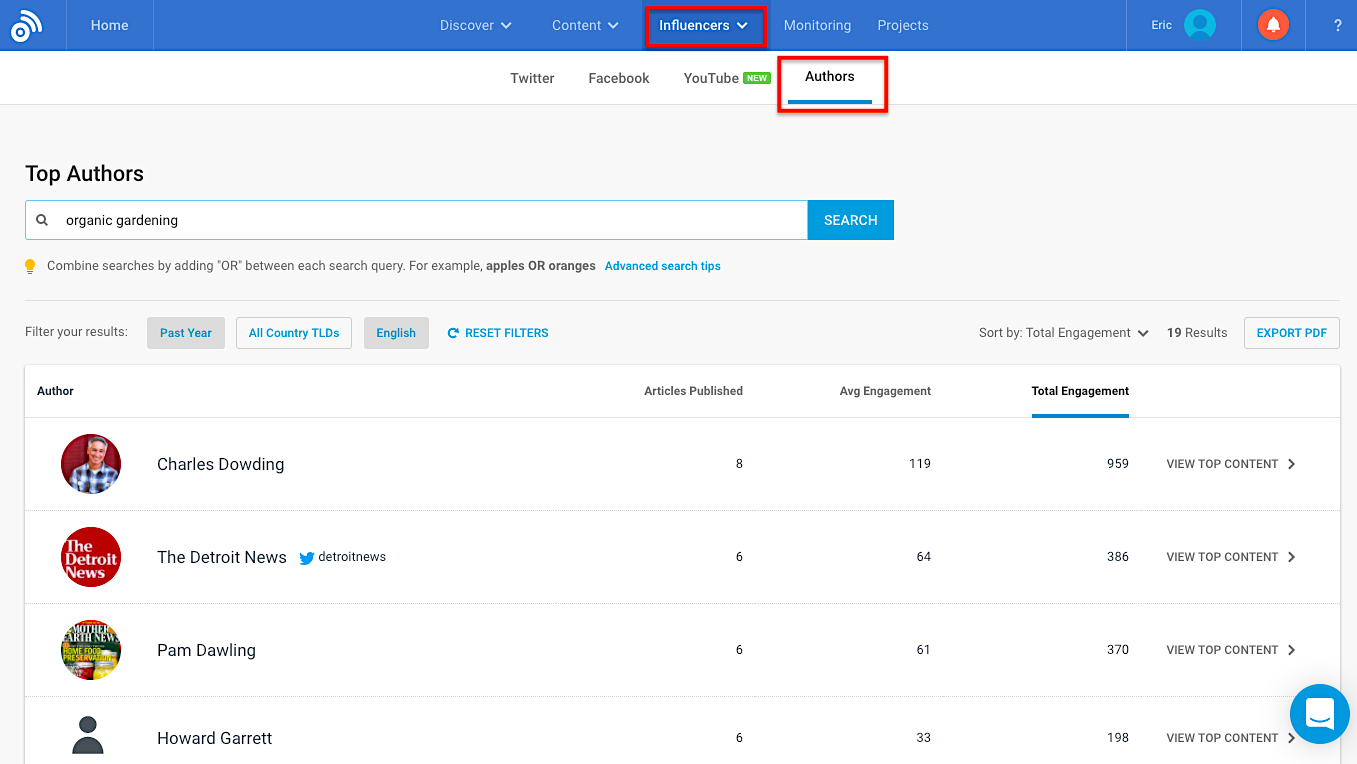
You can also search for influencers by keyword and see important data like number of followers, domain authority, etc.
HYPR
HYPR is a database of more than 12 million influencers, including bloggers and social media personalities, and 30,000+ topic categories. You can search and narrow them down based on audience demographic factors:
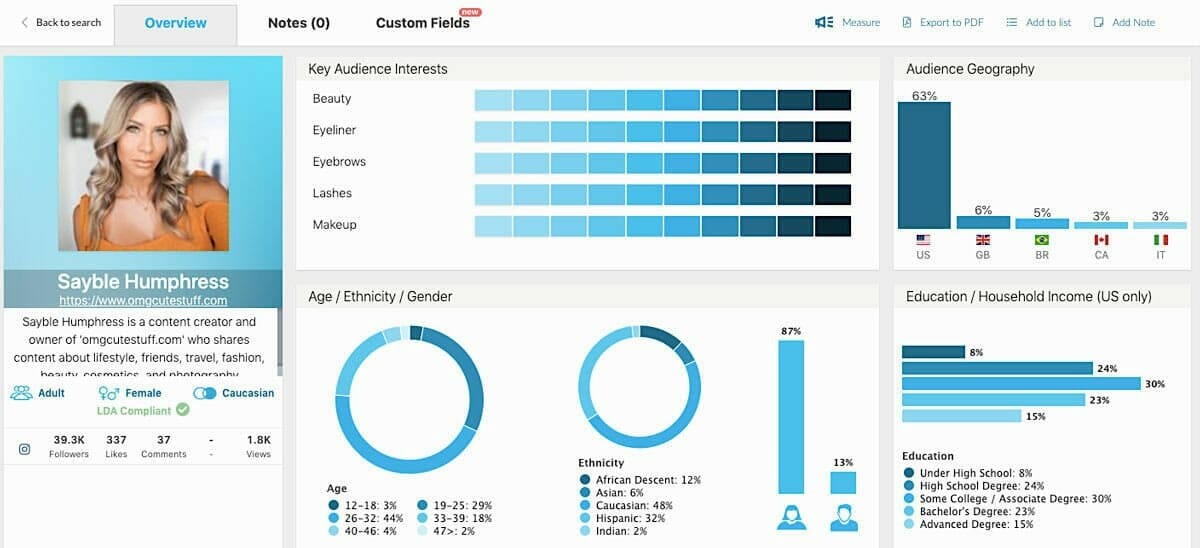
Then you can reach out to the influencers whose audience best matches yours.
Octoly
Octoly is an influencer marketing platform that enables brands to collaborate with a community of 30K+ vetted influencers with a reach of over 3 billion engaged consumers:
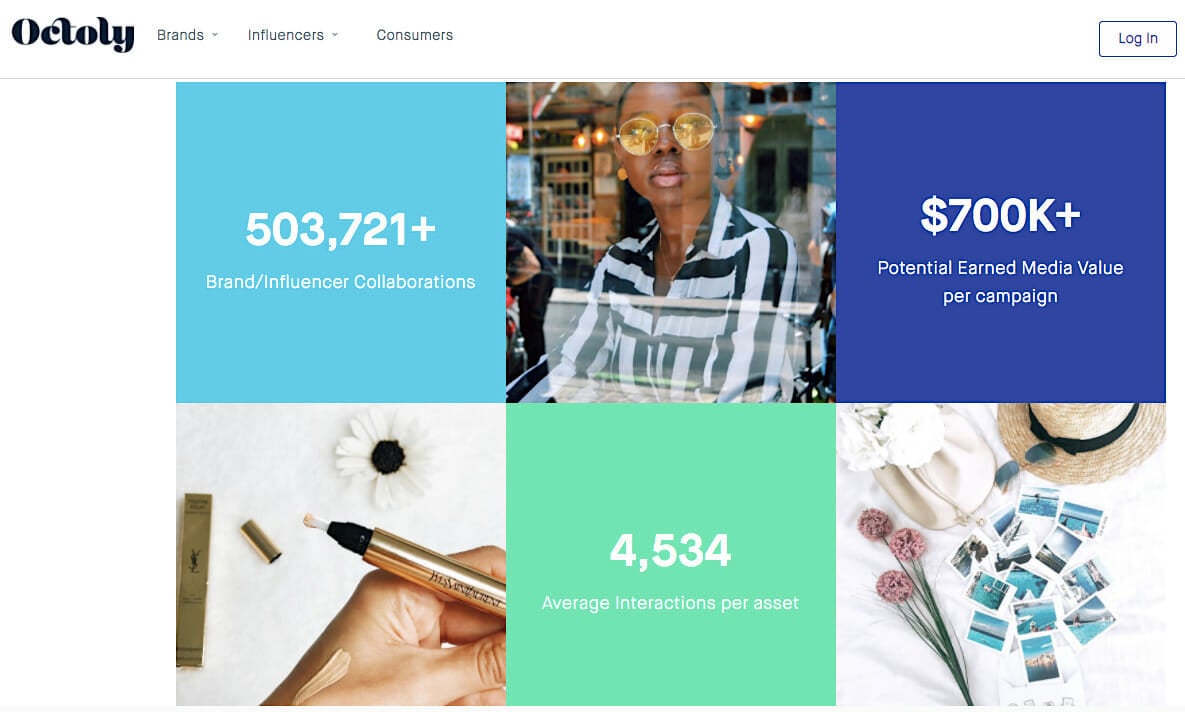
Influenster
If you’re interested in getting product reviews, Influenster can help. Submit your product to their “VoxBoxes” program, and you can ship free samples to their database of influencers. The influencers will post product reviews on the platform and share with their social audience.
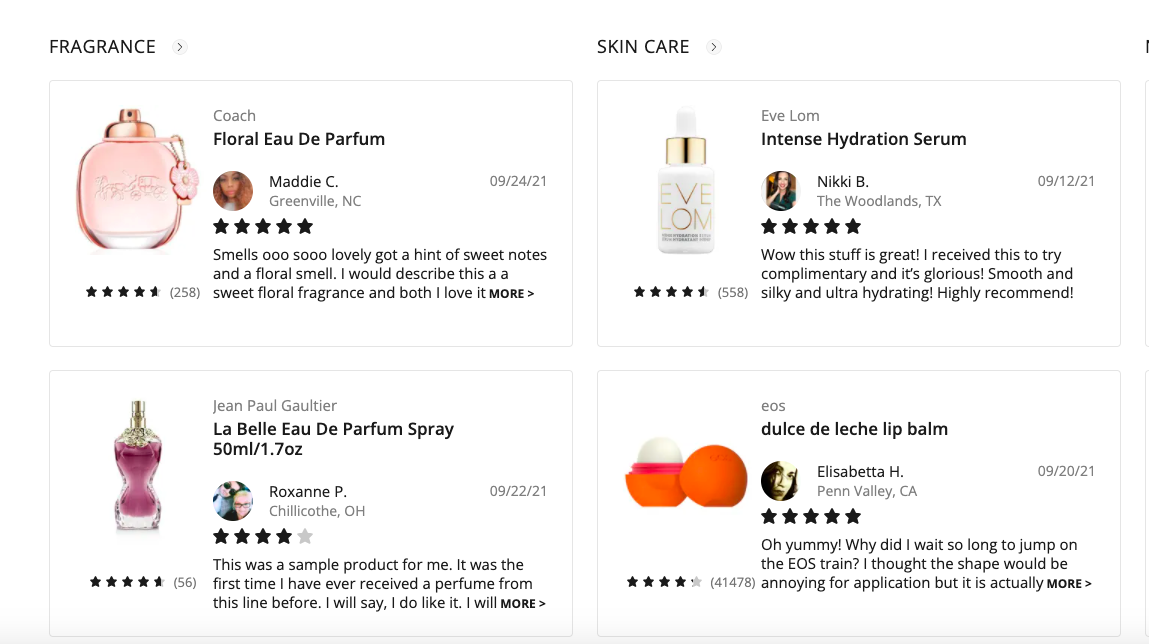
Tribegroup
Tribegroup is a marketplace where you can find and work with social media influencers to promote your brand on Facebook, Instagram, and Twitter:
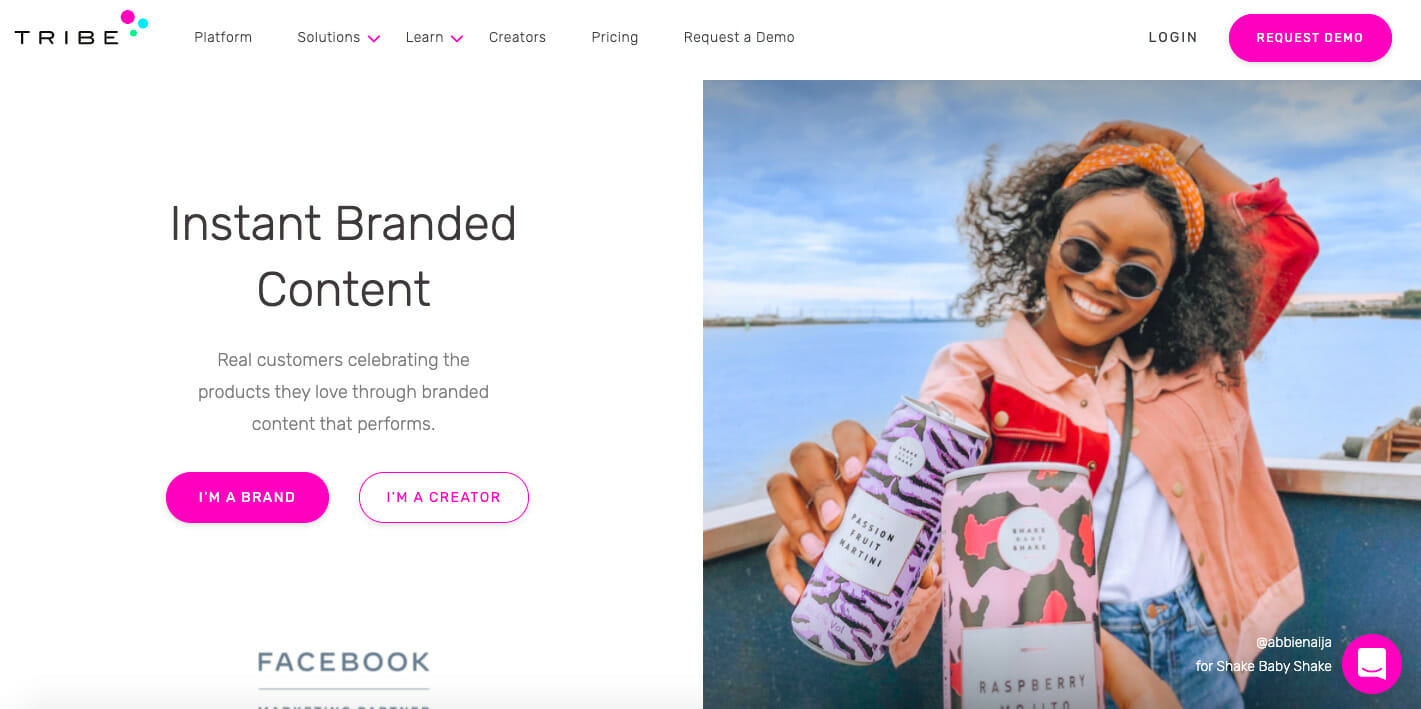
Brands upload a brief of their product and marketing campaign to the platform, then influencers can create their own unique posts about it and submit them to you for approval. If you like it, they share it.
Upfluence
Upfluence considers itself “the smartest influencer marketing platform” because you can find relevant influencers and run better campaigns with their AI-powered, all-in-one platform for smarter, data-driven influencer marketing.
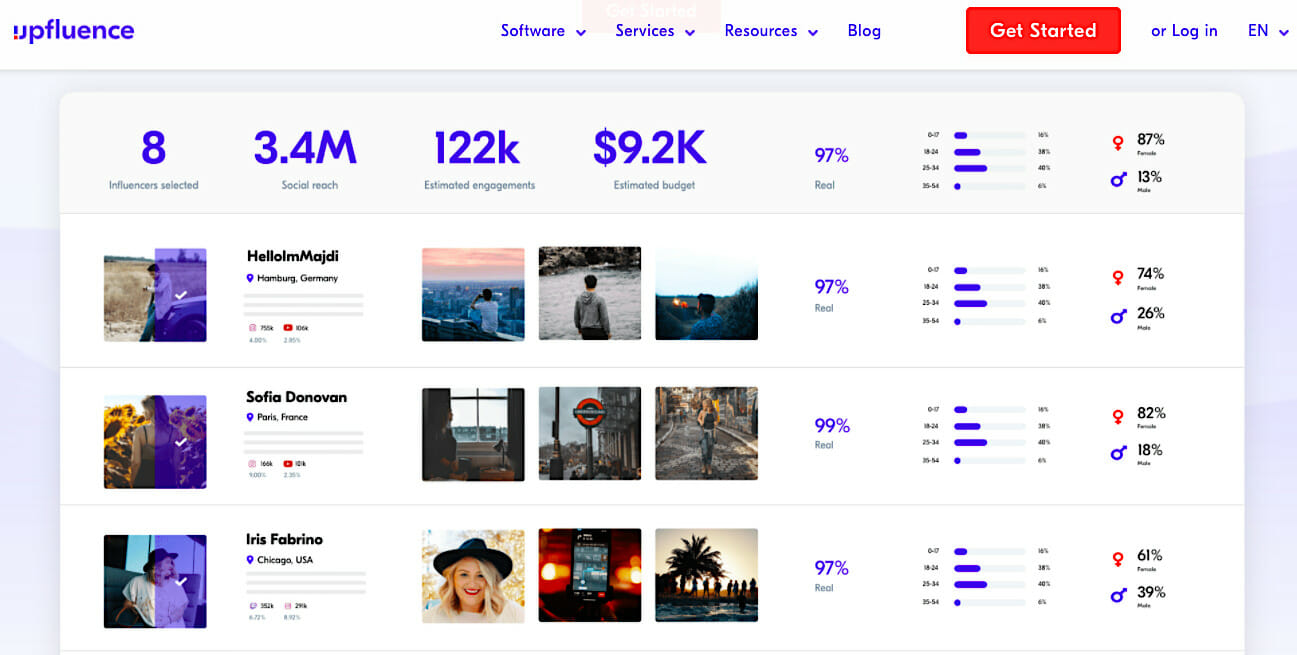
Gone are the days of spreadsheets, endless hours searching for influencers, sending cold invites one by one, and time-consuming campaign reporting. Upfluence makes it easy to find influencers quickly with their data-driven search engine, send automated bulk emails in one go, streamline your campaign workflow, and measure ROI all in one place.
Chapter 8: How to Work with YouTube Influencers to Grow Your Brand
Working with YouTube influencers allows you to leverage two of the most effective forms of advertising – influencer marketing and video marketing.
YouTube, the most popular website for videos in the world, has over 2 billion monthly active users with more than a billion hours of content consumed daily. It is only natural that marketers are inclined to explore the immense potential of YouTube as an advertising tool, like this ad by Nike that generated over 57 million views:
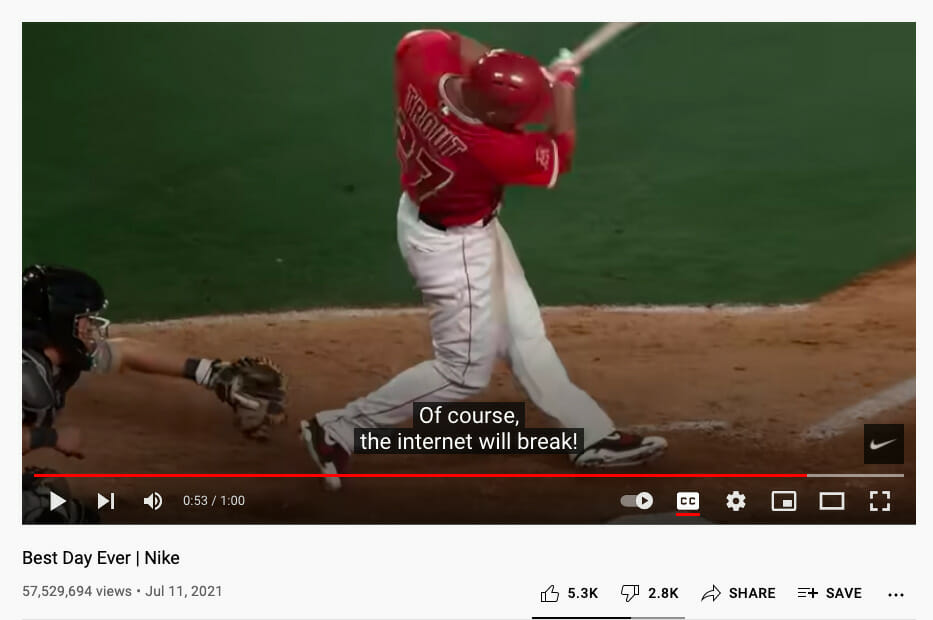
With more than 720,000 hours of video uploaded to YouTube every day, making your content stand out is challenging. This is exactly where YouTube influencers can come to your rescue.
Many YouTube influencers have thousands of subscribers who get a notification every time they upload a new video. When you collaborate with these YouTubers, you get access to this highly engaged audience. Your content also earns credibility due to the friendly rapport these influencers have with their fans.
Here are the most important things to keep in mind when trying to work with YouTube influencers (bear in mind that much of this applies to other influencers, too, but in this section we’ll provide specific YouTube influencer tips).
1) Set Your Goals
In order to execute a successful influencer marketing campaign, it is important to define the outcome you want:
- Do you want to reach a larger audience?
- Maybe you want to create buzz about your products or services?
- Or perhaps you want to generate leads and drive sales through the campaign?
Being clear on your desired outcome will dictate which influencers you should collaborate with, the kind of content you should create for effective collaboration with YouTubers and, thus, how to measure your campaign progress.
So, make sure you have a clearly defined set of goals in mind before you approach any influencer.
2) Choose the Right Influencers
If you randomly pick a YouTube influencer with a lot of subscribers and collaborate with them, your efforts won’t yield significant results. So even before you start ideating, it is important to identify the right influencers to collaborate with.
When selecting an influencer for your marketing campaign, you should take the following points into consideration:
- Relevance – The influencer you choose to work with needs to be relevant to your product, service or industry. Their niche should align with yours. Only then will you be able to grab the attention of their subscribers.
- Reach – Look for relevant influencers with a large number of subscribers on their YouTube channel. They can help you grab more eyeballs with their content.
- Engagement – Reaching a large audience won’t be fruitful unless viewers engage with your content. Don’t be fooled by the high number of subscribers on an influencer’s YouTube channel. Take a closer look at the comments section of their videos – that will tell you how well their audience interacts with their content.
- Experience – It is always better to collaborate with influencers who have worked on similar projects before. Their expertise and insights can further enhance your marketing campaign.
For example, Michael Garrett and Ryan Duey created The Cold Plunge, which is essentially a cold bath designed to improve your health and fitness. At the beginning of COVID-19, they had nothing but an idea. But just a year later, they did $3.5 million in sales and are continuing to grow.
They credit their rapid growth rate to influencers like Tony Robbins, Tony Hawk and other A-listers in the entrepreneurship industry. As these influencers had a large and loyal following of entrepreneurs deeply interested in health and fitness, it was a no brainer to partner with them.
The selection of your influencer will also depend on your budget and ultimate goals. For instance, if you want to target a local audience, working with local micro-influencers can be extremely fruitful. They have a relatively small, yet highly engaged audience. And they are less expensive compared to those with millions of subscribers.
In the case above, the founders of the Cold Plunge only reached out to influencers who already had a cold therapy routine and asked if they could send a free tub (of $3,000 retail value).
Therefore, while sending free products often isn’t enough to earn an influencer marketing partnership, it likely worked in this case because:
- The influencers already demonstrated interest in products similar to The Cold Plunge
- There weren’t any other comparable cold plunge devices on the market
- The product had a $3,000 value, so giving it away for free had substantial value
How to Find YouTube Influencers
You can simply run a Google or YouTube search to get a list of the most popular and relevant influencers and then take a look at their YouTube channels to get an idea of the content they are creating.
Navigate to the “About” section on their channel to get their contact details:
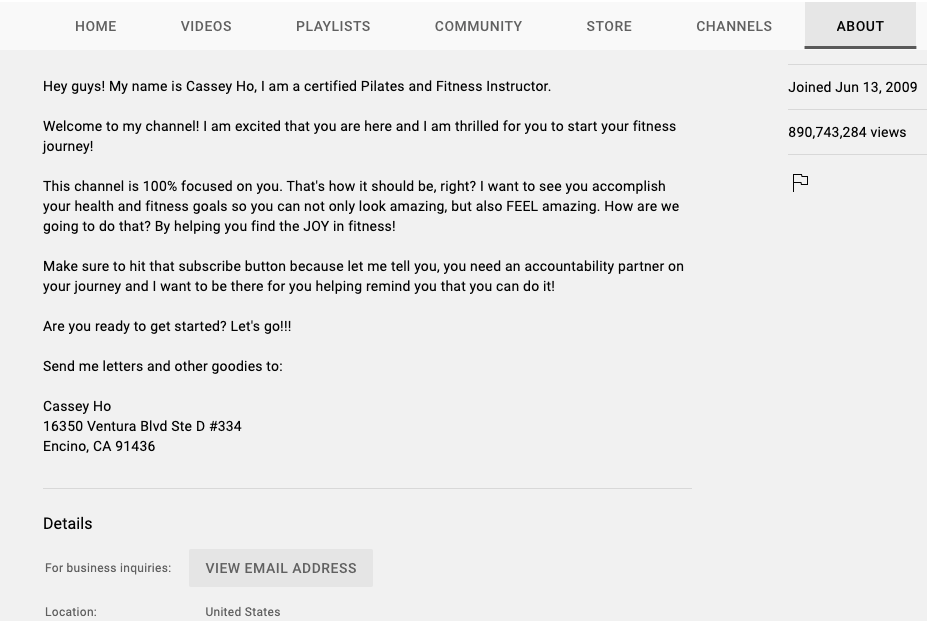
However, you might not have the time it takes to search through hundreds of channels for the best fit, and might want to look at more detailed channel demographics.
For such scenarios, you can also use a data-driven influencer platform like BrandConnect, YouTube’s branded content platform, to find the right influencers for you.
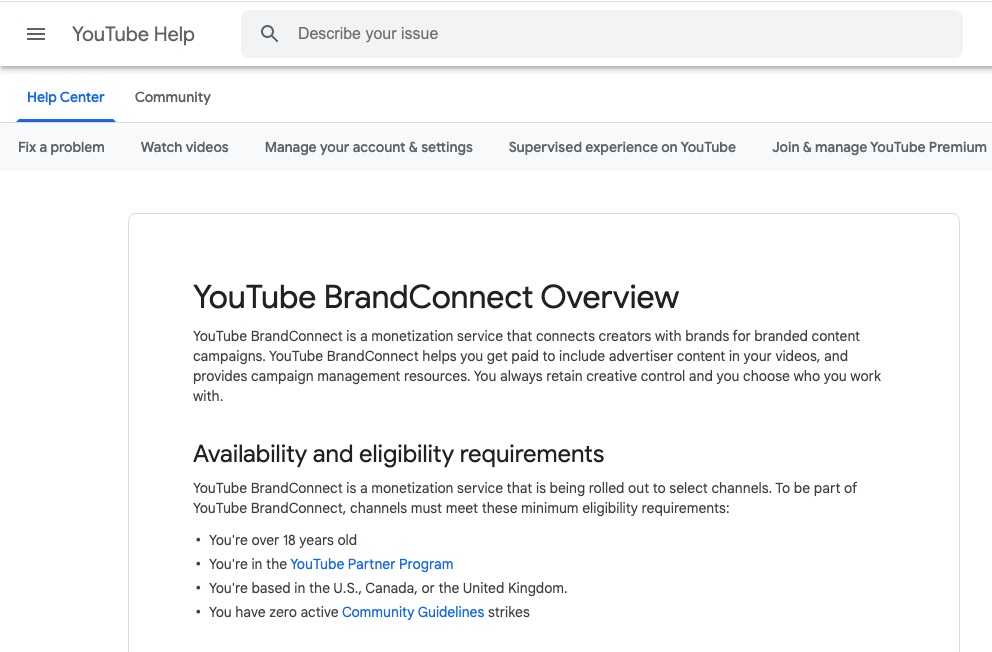
3) Create User-Centric Content
Video is an extremely effective tool for communicating crucial information in an interesting and easy-to-digest format, and is incredibly effective at brand awareness.
However, creating a video that goes on and on about how awesome your product or service is won’t be of much use. Instead, you need to develop an interesting narrative around your brand to grab the attention of your target audience.
In addition, you need to communicate how your product or service can help resolve their problem. Seasoned YouTubers already have a fair idea of what works well with their audiences.
Here are a few types of videos you can partner with influencers to create:
Product Reviews and Testimonials
In a fiercely competitive consumer market, it is difficult to win the trust of potential customers. They are less likely to rely on brands that sing songs of self-praise.
Instead, they trust recommendations and testimonials from real-life users such as friends, acquaintances and influencers. In fact:
- 92% of consumers trust influencers more than traditional celebrities
- 33% of consumers trust influencers when making shopping decisions, though only 17% trusted friends and family for shopping recommendations.
- 63% of consumers trust influencer messaging more than brand messaging
So if your goal is to generate leads and increase sales, you can ask your influencers to create honest product review videos. Give them the freedom to share their own experiences with your brand, outlining both the pros and cons. Coming from a trusted influencer, such a review is likely to foster brand awareness, add credibility to your product or service, and inspire your target audience to purchase it.
This is exactly the strategy that was adopted by Yubico, a hardware authentication company. They collaborated with YouTuber Linus Sebastian of Linus Tech Tips, which has over 14 million subscribers.
They worked with him to create and upload a detailed review of their product. The video has garnered nearly a million views, 57,000 likes and over 3,000 comments:
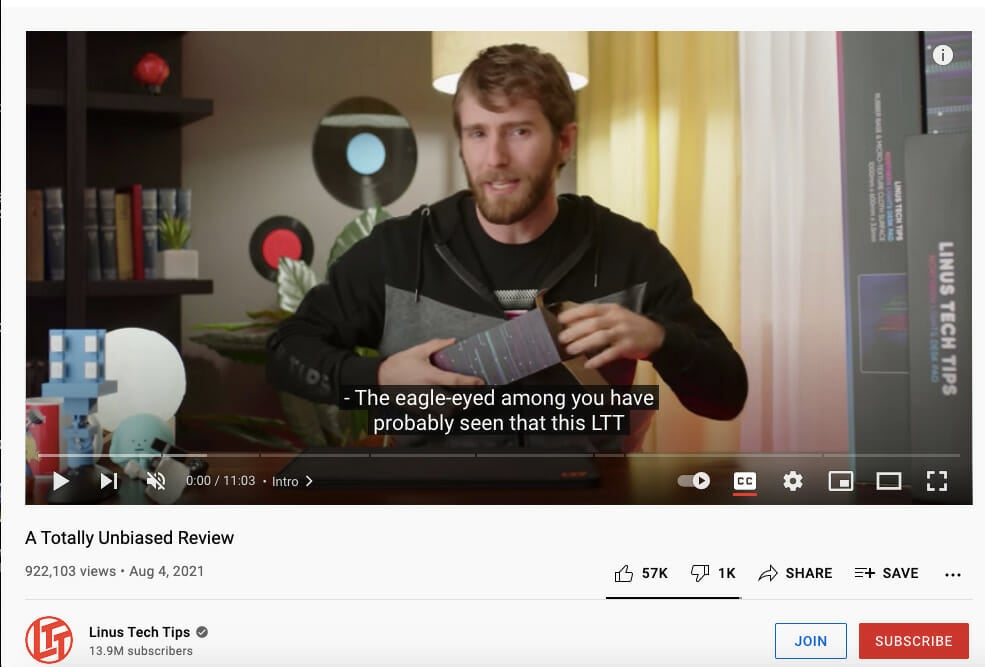
Storytelling for Your Brand
Videos with strong narratives often stand out amidst the plethora of random content. Furthermore, if your target audience enjoys the video, they are likely to share it on their social media profiles. As a result, your content will reach a far wider audience.
Although this might not drive direct conversions, it is extremely effective in generating brand awareness and customer engagement.
Google recently did a collaboration with comedic skit influencer, Lele Pons. Rather than having her review a product, she included Google products throughout the video.
In the skit, you follow her through planning a Quinceañera and she uses Google Assistant products to help plan her day. The video has amassed nearly 13 million views, over 244,000 likes and nearly 10,000 comments:
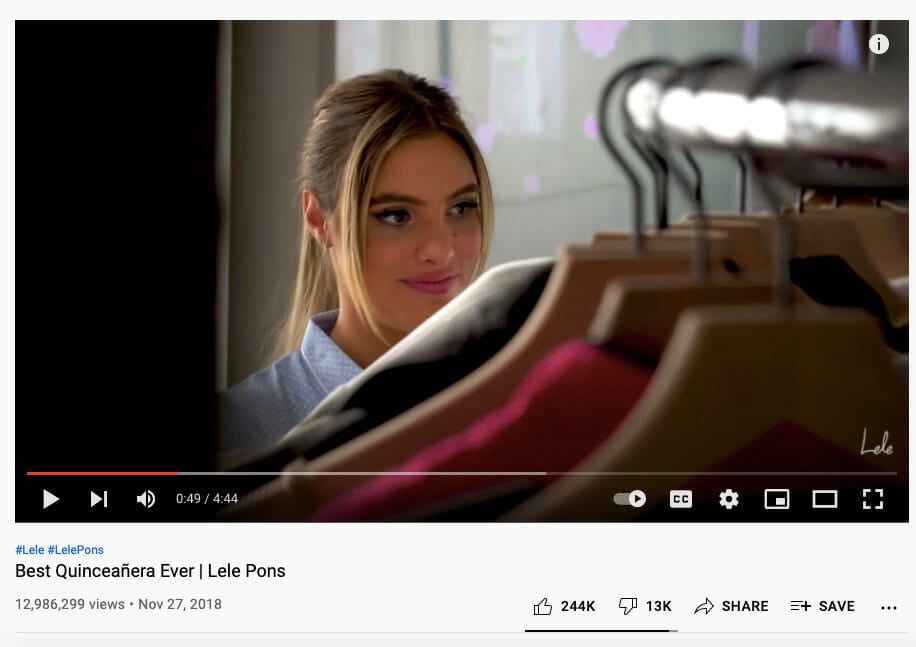
Tutorials, Demos and How-to Videos
Educating your target audience about how your product or service works can influence their purchase decisions. Video, being an effective and effortless communication tool, is the ideal format to create tutorials or demos showcasing your products. Since influencers are perceived as industry experts, having them create a how-to video can bring exceptional results.
Coming from influencers, such videos can increase your brand’s visibility and reinforce brand trust. They can also be helpful in lead generation.
Tecno, a smartphone manufacturer, adopted this strategy to promote their new product, the TECNO PHANTOM X Smartphone. The company partnered with Lewis Hilsenteger of Unbox Therapy, who created a video demonstrating how the new product works.
The video garnered immediate traction because Unbox Therapy’s audience consists of people who are interested in the latest technologies. It received more than 1 million views on YouTube and over 31,000 likes:
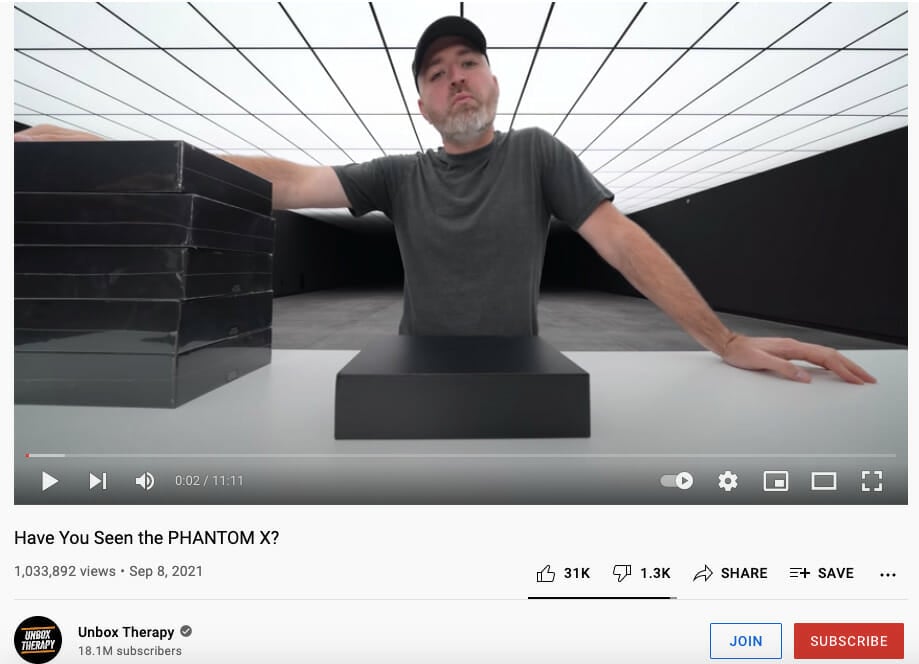
These videos also serve as a double promotion as the company can later use this influencer’s review when marketing the product.
4) Insert Calls-to-Action
If an influencer’s audience likes your content, they may want to know more about your brand. Including a clickable link in the video or adding a link in the video description prompts them to take immediate action.
In addition to raising brand awareness, it can also drive organic traffic to your website. This can have a positive impact on your website’s search engine rankings as search engines love to see positive user signals such as long dwell times and low bounce rates.
Conversion copywriter Peter Boyle recommends these rules to ensure that your CTAs cause users to take action:
- Use value-focused words
- Test different color combinations (try to find contrasting yet complementary colors)
- Place the CTA at the logical decision-making points on the page
- Utilize urgency elements for more immediate action
- Keep a 1:1 ratio between actions and conversion goals
5) Keep Your Legal Documents Handy
It is advisable to sign a legal contract when working with YouTube (or any) influencers because it helps to define roles, timelines, deliverables and payment terms in a clear and irrefutable way.
If all goes well, you might never have to take a second look at the contract. However, it can be useful in case there is a dispute between you and the influencer. Having everything on paper helps avoid miscommunication and complications.
Influencer Marketing Hub offers influencer contract templates as well as some typical points you should include in your own influencer contract:
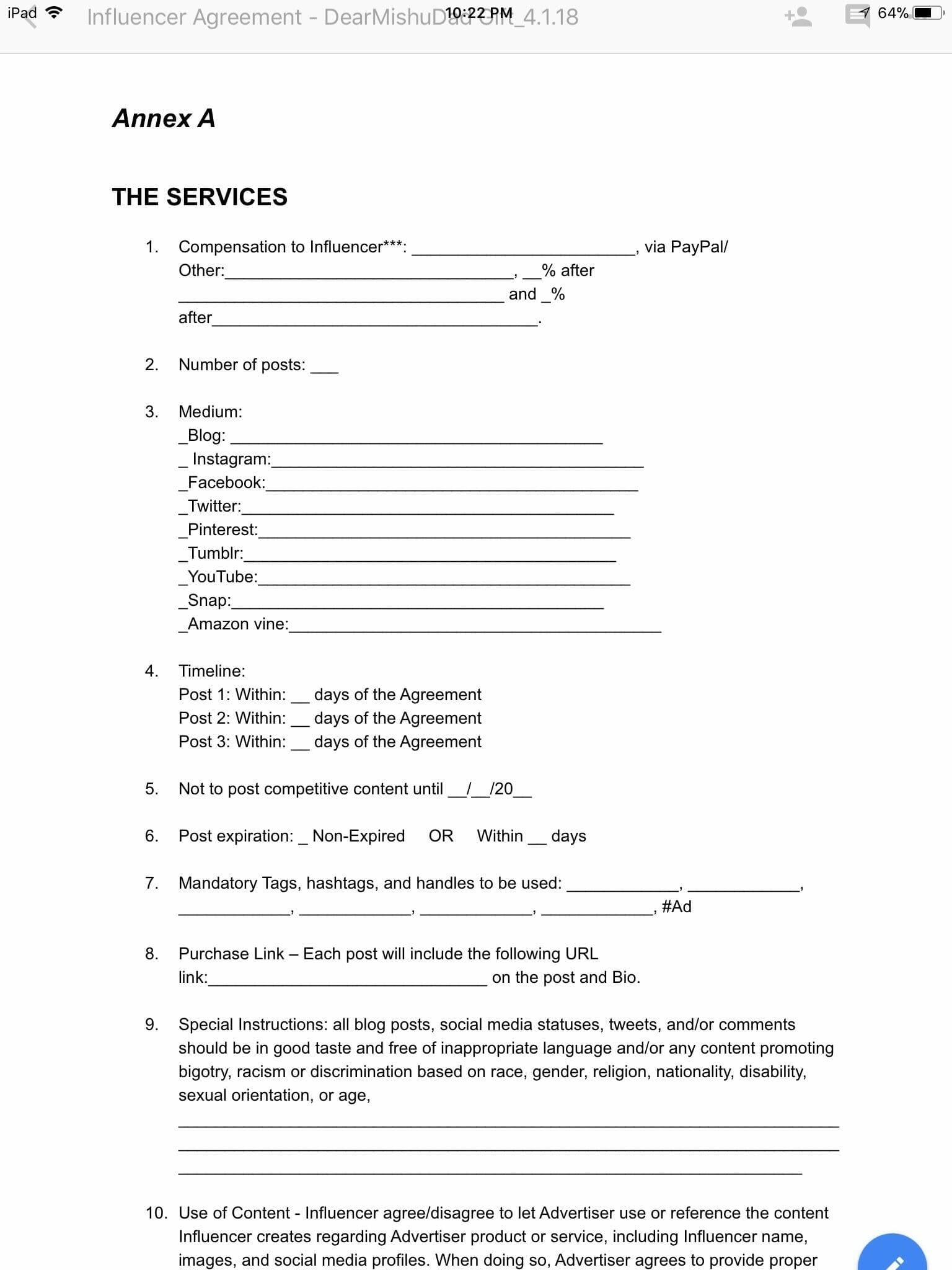
6) Engage Continuously
Your collaboration with a YouTube influencer doesn’t end when the final video is uploaded to their channel. Once the video is released, you have a whole new set of responsibilities. In order to make your campaign truly successful, you need to monitor how the audience interacts with your content.
- Respond to Comments. A good way to start a conversation about your brand is by replying to the comments posted by viewers. If they have provided feedback, thank them for doing so. If they are soliciting more information, offer to answer all their questions.
- Keep in Touch. It isn’t a good idea to abandon a YouTube influencer once you have successfully executed your marketing campaign with them. You should strive to build and maintain a long-term association with them. Keep them updated on the latest company news. Once in a while, send them incentives in the form of freebies or discount vouchers. This will help build strong relationships with influencers.
Chapter 9: All You Need to Know About the ROI of Influencer Marketing
Influencer marketing is helping big brands reach out to more people and it’s helping small businesses scale better by giving them more publicity. And the best part is that it provides better ROI than other marketing methods.
89% of all marketers find ROI from influencer marketing comparable to or better than other marketing channels:
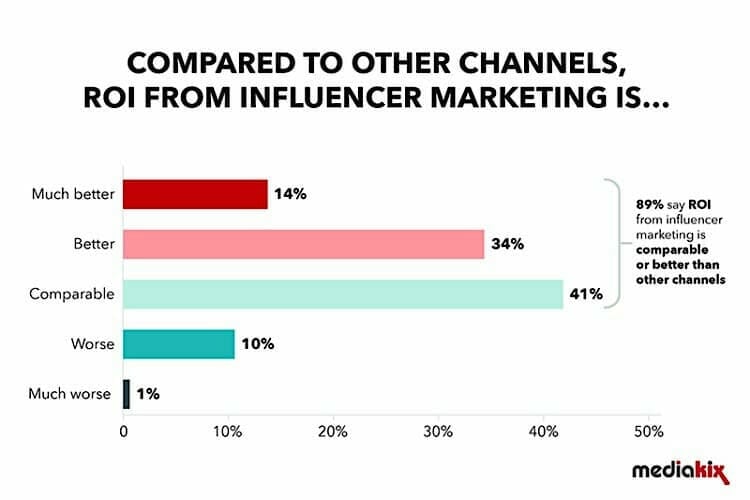
But how do you calculate ROI from influencer marketing?
Check out this infographic!

Start Your First Influencer Marketing Campaign Today!
Despite its rise in popularity, influencer marketing is still an underutilized channel and it will continue to be an important marketing strategy in businesses for years to come.
Now that you know everything you could possibly want to know about influencer marketing, get started with your first campaign today. It might take some trial and error to find what works for your brand, though in time, you’ll find that a solid influencer marketing strategy is one of the most powerful marketing strategies to quickly tap into new audiences and generate quality customers.
If you need help starting your influencer marketing campaign, feel free to talk to our team of digital marketing experts. Just click the orange button 👇
Case Studies: How Influencer Marketing Helped Multi-Million Dollar Companies:
- What Yanik Silver Learned About Work – and Play – From Richard Branson
- How Entrepreneur Gretta Van Riel Used Her 16M Social Media Following to Grow Her Businesses
- How YouTube Influencer & Banish CEO Daisy Jing Launched Her Successful Skincare Line
- How FabFitFun Uses Influencer Marketing to Grow 3x Yearly
